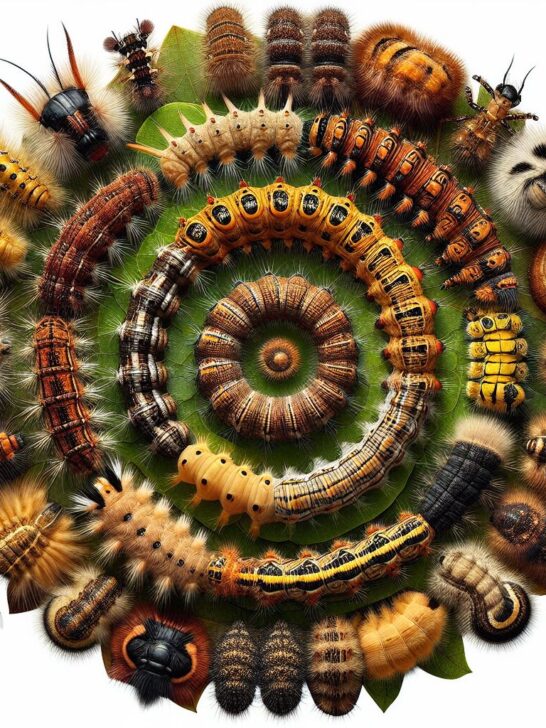Caterpillars are the larval stage of butterflies and moths, and they exhibit an incredible diversity of colors, shapes, and sizes. Among the various caterpillar colors, brown caterpillars are one of the most common types found in different habitats worldwide.
Caterpillars are the larval stage of butterflies and moths, showcasing a remarkable diversity in colors, shapes, and sizes. Among the myriad hues exhibited by caterpillars, brown is one of the most prevalent, with various species found across different habitats worldwide. This comprehensive guide explores the intriguing world of brown caterpillars, providing detailed insights into their scientific names, habitats, descriptions, diets, and host plants.

Post Contents
- Achemon Sphinx Caterpillar
- Ailanthus Webworm Caterpillar
- Ambiguous Moth Caterpillar
- Banded Woolly Bear
- Bicolored Sallow Caterpillar
- Black Cutworm Caterpillar
- Black Witch Caterpillar
- Common Tan Wave Caterpillar
- Curved-toothed Geometer Moth Caterpillar
- Dark-spotted Palthis Caterpillar
- Eastern Tiger Swallowtail Caterpillar
- European Corn Borer Caterpillar
- Exposed Bird Dropping Moth Caterpillar
- Horned Spanworm Caterpillar
- Imperial Moth Caterpillar
- Juniper Geometer Caterpillar
- Large Yellow Underwing Caterpillar
- Little Wood Satyr Caterpillar
- Lunate Zale Moth Caterpillar
- Nessus Sphinx Caterpillar
- One-spotted Variant Caterpillar
- Pandora Sphinx Moth Caterpillar
- Pearl Crescent Caterpillar
- Pink-Spotted Hawkmoth Caterpillar
- Pipevine Swallowtail Caterpillar
- Porcelain Gray Caterpillar
- Red-fringed Emerald Caterpillar
- Ruby Tiger Moth Caterpillar
- Salt Marsh Caterpillar
- Striped Garden Caterpillar
- Tulip-tree Beauty Caterpillar
- Two-tailed Swallowtail Caterpillar
- Unicorn Moth Caterpillar
- Variegated Cutworm
- Variegated Fritillary Caterpillar
- Viceroy Caterpillar
- Wedgling Moth Caterpillar
- Western Tiger Swallowtail Caterpillar
- White-speck Moth Caterpillar
- Yellow Woolly Bear Caterpillar
- Yellow-Striped Armyworm Caterpillar
- Conclusion:
Achemon Sphinx Caterpillar
Scientific Name: Eumorpha achemon
Habitat: Achemon Sphinx Caterpillars can be found in deciduous forests, woodlands, and suburban areas across North America, where their host plants grow abundantly.
Description: These caterpillars are large and robust, featuring a striking green coloration with diagonal white stripes along their bodies. They possess a distinctive horn at the rear end, typical of many sphinx moth caterpillars.
Diet: Achemon Sphinx Caterpillars primarily feed on the leaves of grape (Vitis spp.) and Virginia creeper (Parthenocissus quinquefolia) vines, making them occasional pests in vineyards and gardens.
Host Plants: Grape and Virginia creeper vines serve as the primary host plants for the Achemon Sphinx Caterpillar.
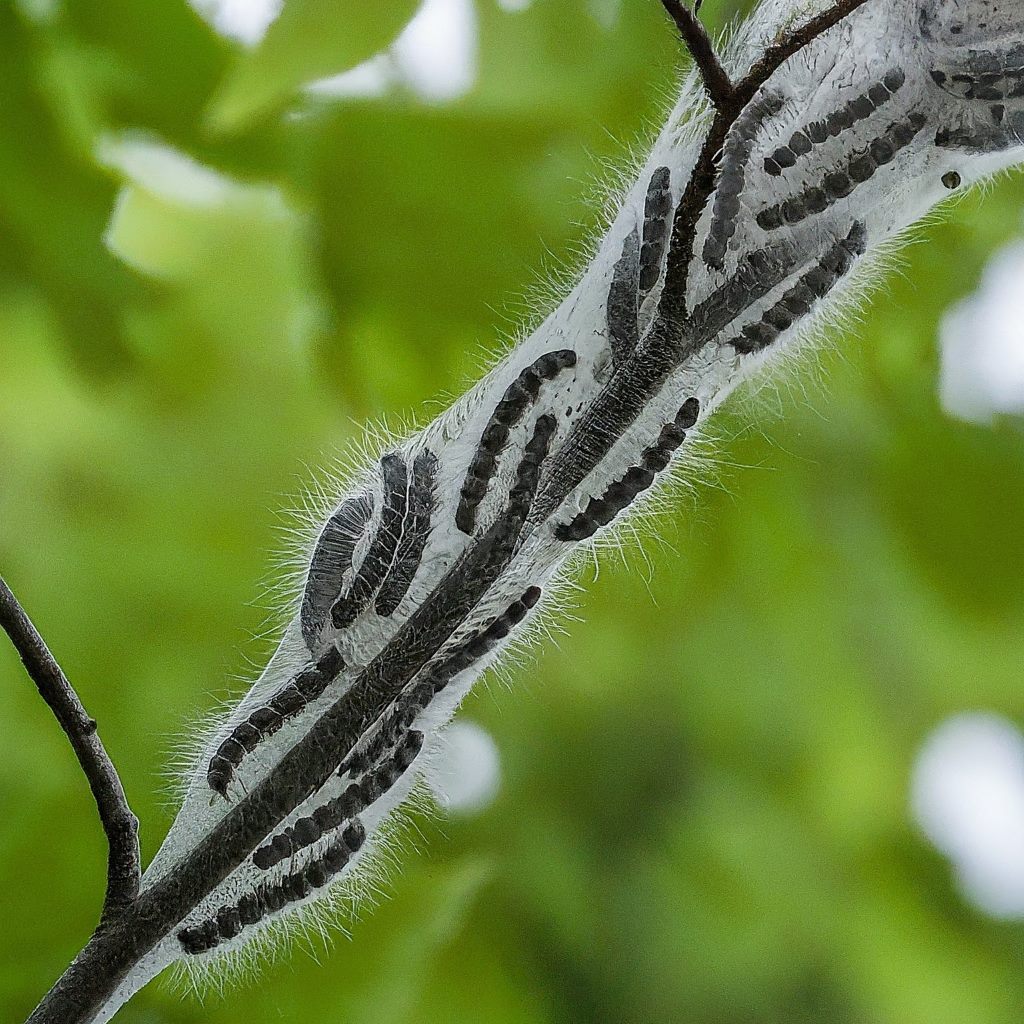
Ailanthus Webworm Caterpillar
Scientific Name: Atteva aurea
Habitat: Ailanthus Webworm Caterpillars inhabit a variety of habitats, including forests, woodlands, and urban areas, where their host plants are prevalent.
Description: These caterpillars are small and slender, featuring a yellow body adorned with black spots and a distinct red head capsule. They exhibit vibrant coloration, serving as a warning to potential predators.
Diet: The larvae of the Ailanthus Webworm Caterpillar feed on the leaves of Ailanthus (Tree of Heaven) and other trees in the Simaroubaceae family.
Host Plants: Ailanthus (Tree of Heaven) is the primary host plant for the Ailanthus Webworm Caterpillar, but they may also feed on other trees within their range.
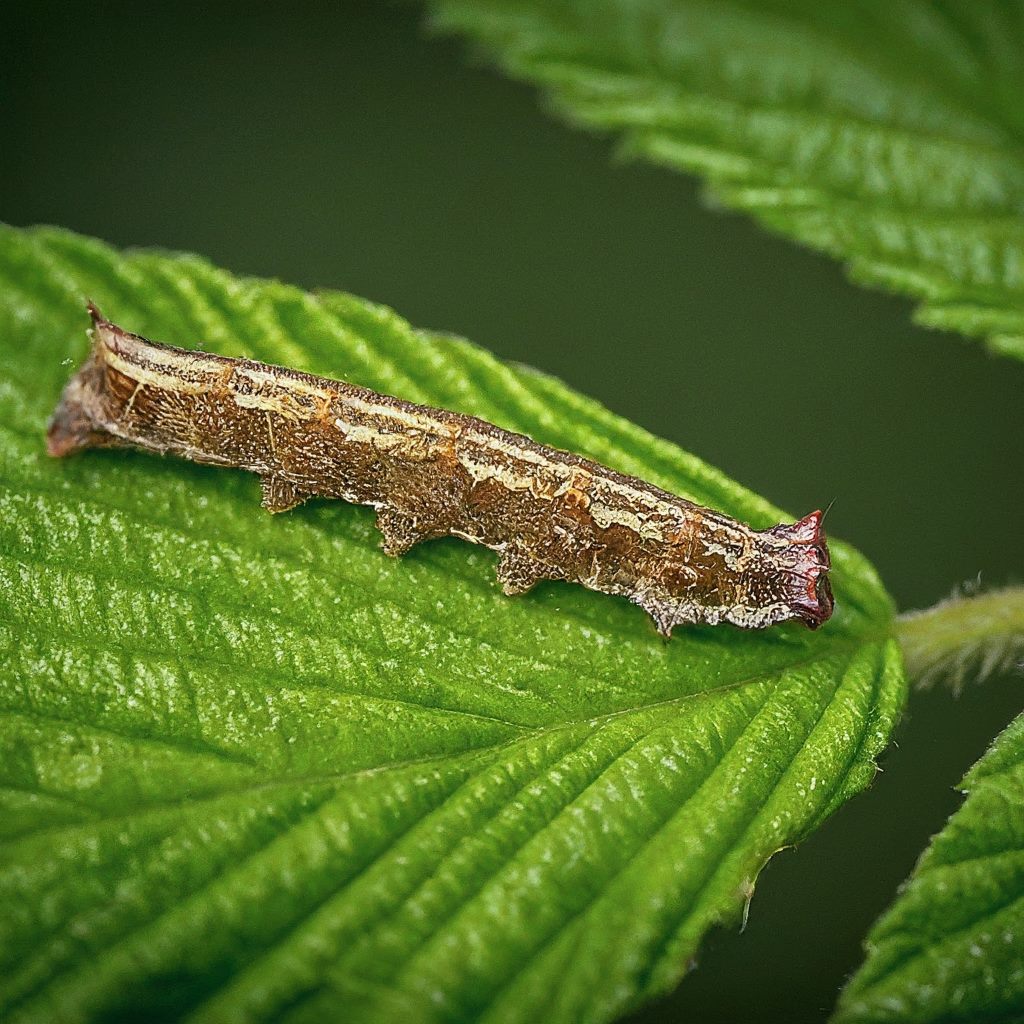
Ambiguous Moth Caterpillar
Scientific Name: Dyspyralis ambigua
Habitat: Ambiguous Moth Caterpillars inhabit a wide range of habitats, including grasslands, meadows, and agricultural areas, where their host plants are commonly found.
Description: These caterpillars are relatively small and inconspicuous, characterized by their brown coloration with subtle patterns and markings. They have a slender body and move with a looping motion.
Diet: Ambiguous Moth Caterpillars feed on various grasses and herbaceous plants, consuming the foliage and tender shoots as they grow.
Host Plants: Their diet includes a diverse array of grasses and plants, making them adaptable to different habitats and ecosystems.
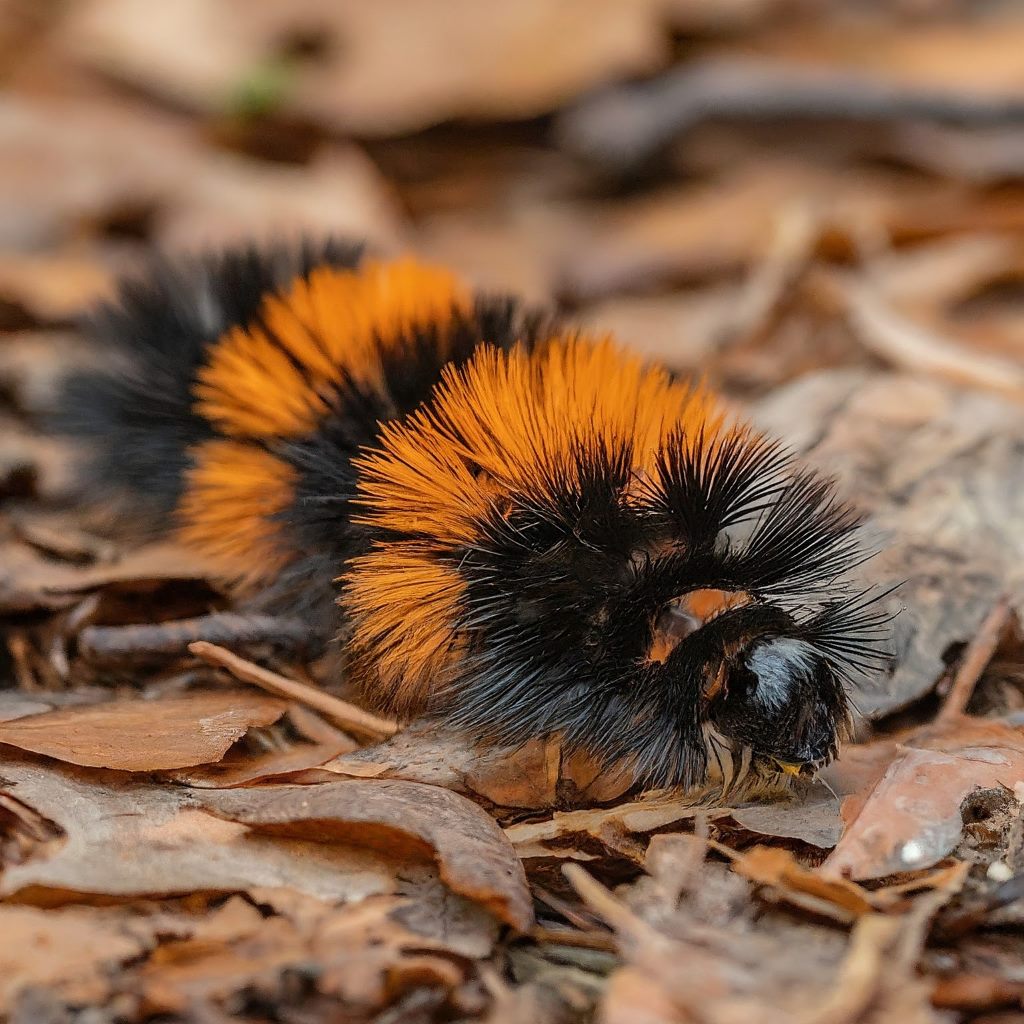
Banded Woolly Bear
Scientific Name: Pyrrharctia isabella
Habitat: Banded Woolly Bear Caterpillars inhabit a wide range of habitats, including grasslands, meadows, and suburban areas, where their host plants grow abundantly.
Description: These caterpillars are known for their distinctive banded appearance, featuring alternating orange and black segments along their bodies. They are covered in fine hairs, giving them a fuzzy or woolly texture.
Diet: Banded Woolly Bear Caterpillars feed on the foliage of various herbaceous plants, including grasses, dandelions, and nettles, as well as the leaves of shrubs and trees.
Host Plants: They are known to feed on a wide range of herbaceous plants, making them adaptable to different habitats and food sources.
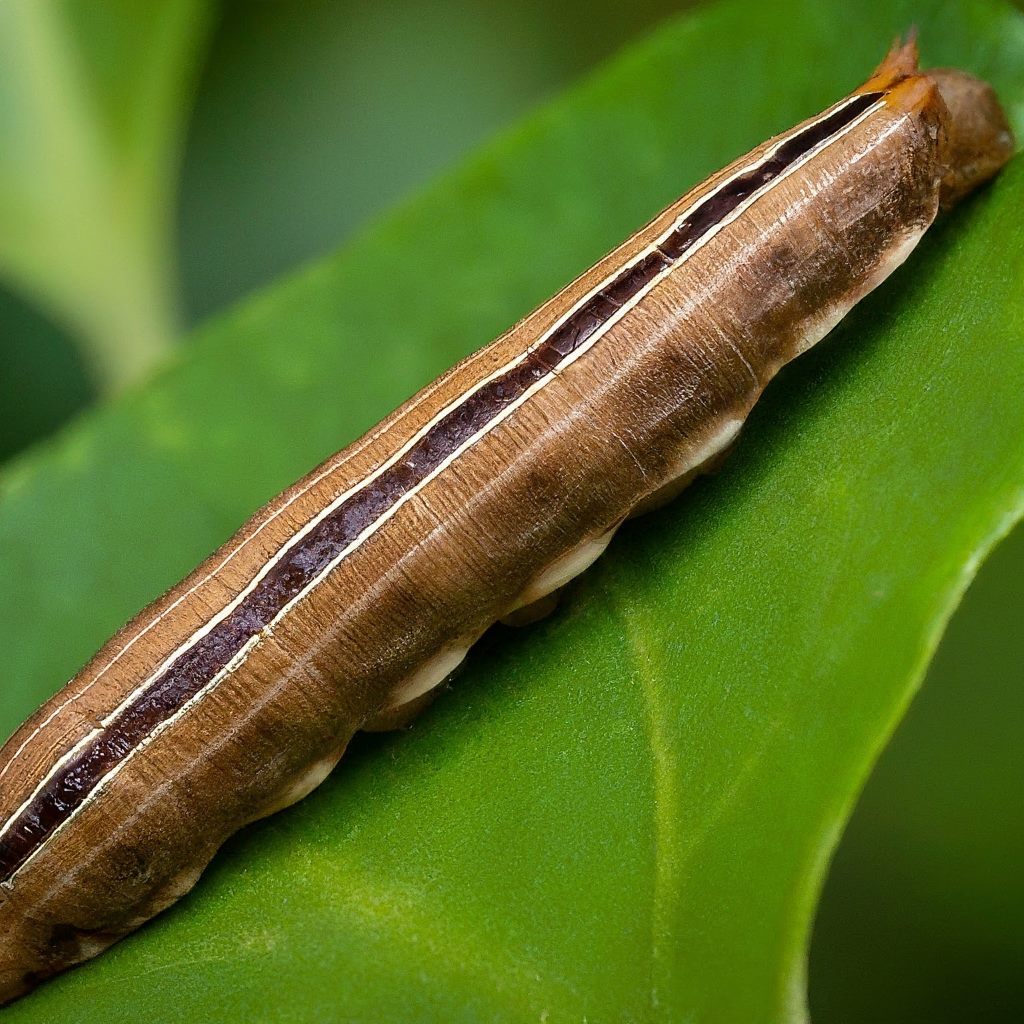
Bicolored Sallow Caterpillar
Scientific Name: Sunira bicolorago
Habitat: Bicolored Sallow Caterpillars inhabit deciduous forests, woodlands, and suburban areas across North America, where their host plants are commonly found.
Description: These caterpillars exhibit a striking appearance, featuring two distinct color bands along their bodies. They are typically brown or tan with darker markings and patterns.
Diet: Bicolored Sallow Caterpillars feed on the leaves of various deciduous trees and shrubs, including oaks, maples, and willows, as well as other herbaceous plants.
Host Plants: Various deciduous trees and shrubs serve as host plants for the Bicolored Sallow Caterpillar, providing ample food sources throughout their development.
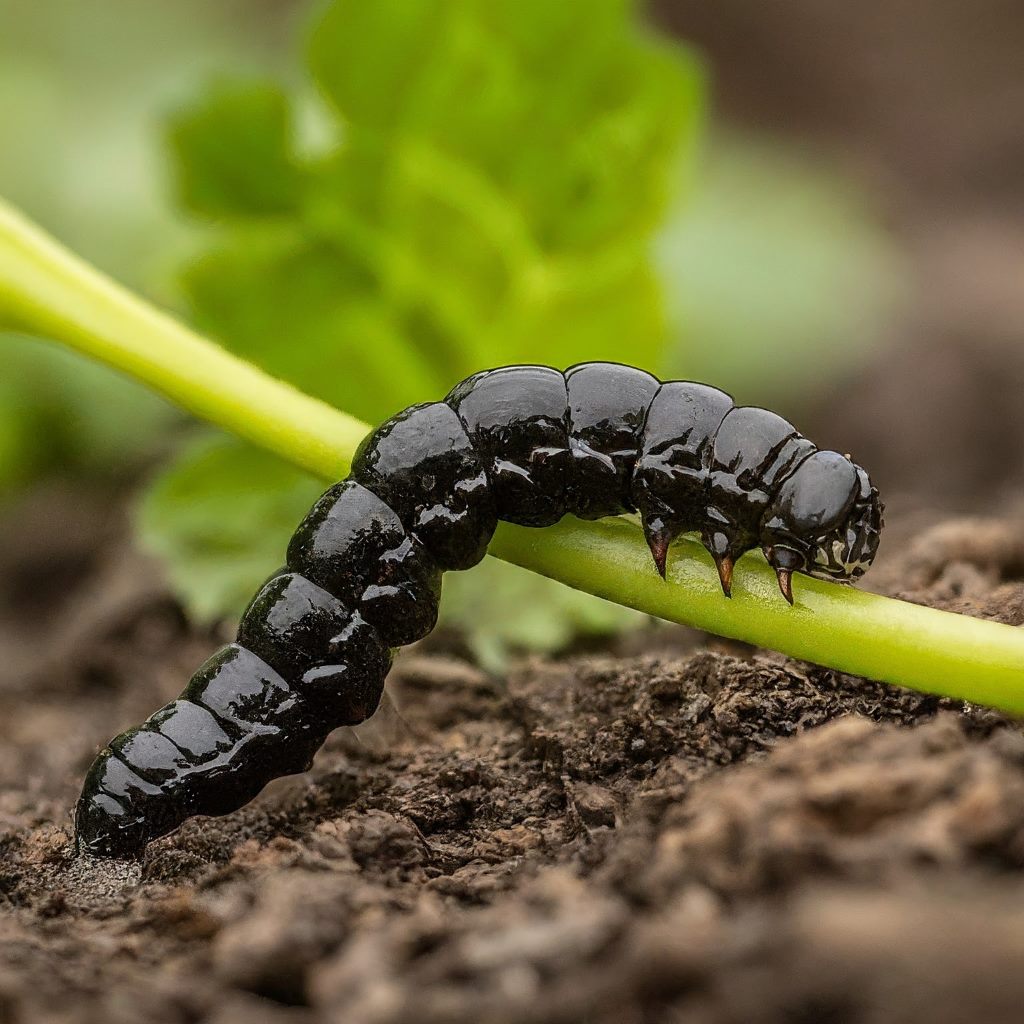
Black Cutworm Caterpillar
Scientific Name: Agrotis ipsilon
Habitat: Black Cutworms are commonly found in agricultural areas, including fields, pastures, and gardens, where their host plants are cultivated.
Description: These caterpillars range in color from dull brown to black, featuring a smooth body with few distinguishing markings. They have a cylindrical shape and move with a looping or crawling motion.
Diet: Black Cutworms are notorious pests of agricultural crops, feeding on the foliage, stems, and roots of various plants, including corn, soybeans, and vegetables.
Host Plants: Various agricultural crops serve as host plants for the Black Cutworm, posing a threat to crop yields and agricultural productivity.
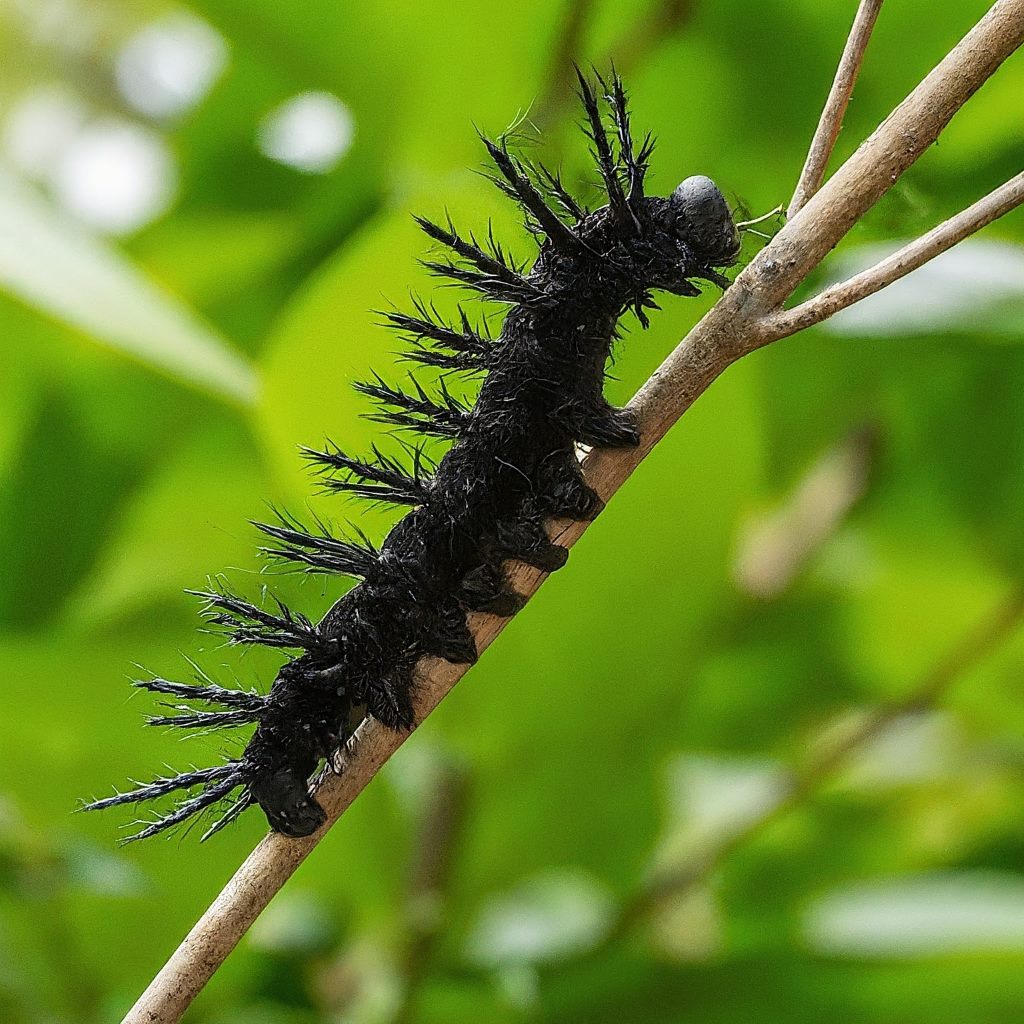
Black Witch Caterpillar
Scientific Name: Ascalapha odorata
Habitat: The habitat of Black Witch Caterpillars is diverse, including tropical and subtropical forests, woodlands, and urban areas, where their host plants grow abundantly.
Description: These caterpillars have a dark brown or black coloration with subtle patterns and markings. They are relatively inconspicuous compared to other species and blend in well with their surroundings.
Diet: While the exact host plants of the Black Witch Caterpillar are not well-documented, they are associated with several tree species found in their native range.
Host Plants: Although specific host plants are not confirmed, Black Witch Caterpillars may feed on a variety of tree species, including members of the legume and mimosa families.
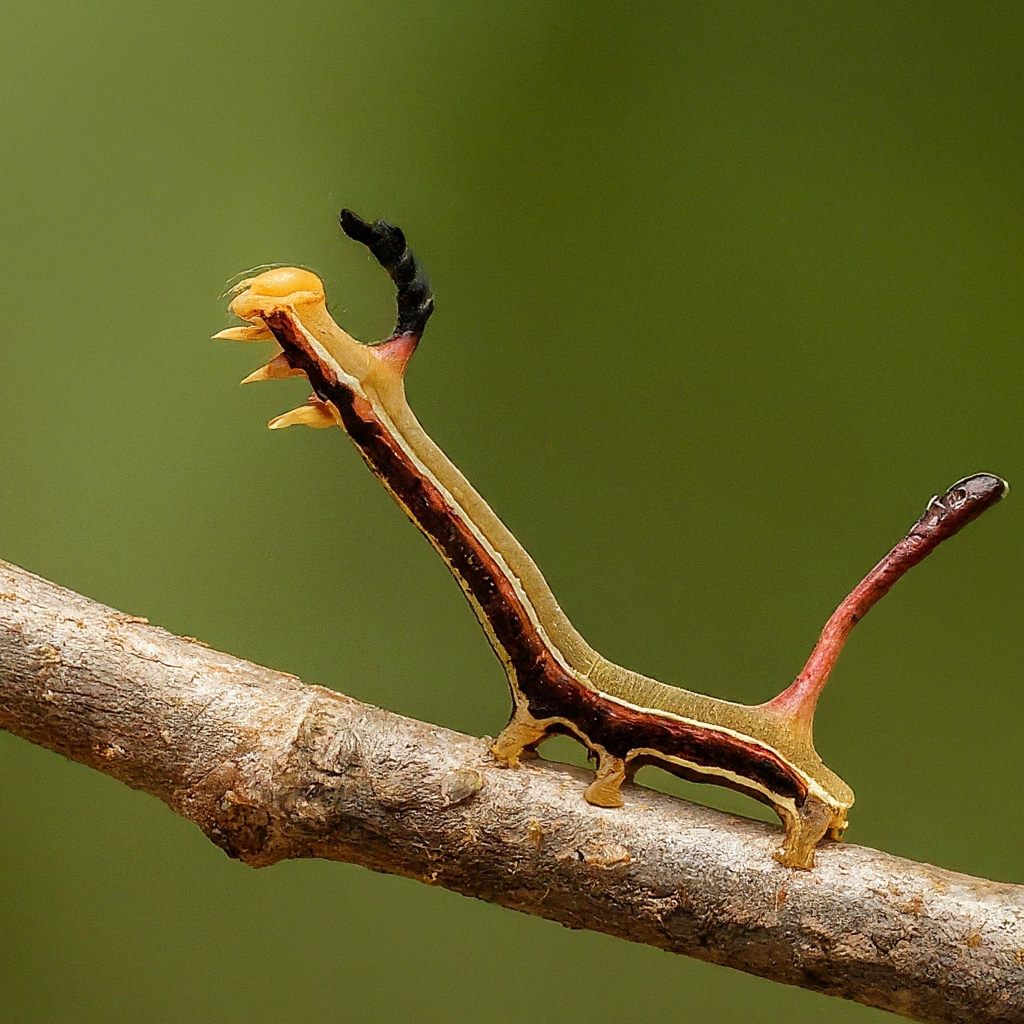
Common Tan Wave Caterpillar
Scientific Name: Pleuroprucha insulsaria
Habitat: Common Tan Wave Caterpillars inhabit a variety of habitats, including forests, woodlands, and urban areas, where their host plants grow abundantly.
Description: These caterpillars exhibit a tan or light brown coloration with intricate patterns and markings along their bodies. They have a slender shape and move with a looping or crawling motion.
Diet: Common Tan Wave Caterpillars feed on the leaves of various trees and shrubs, including oaks, maples, and hickories, as well as other herbaceous plants.
Host Plants: Their diet includes a diverse array of deciduous trees and shrubs, providing ample food sources throughout their development.
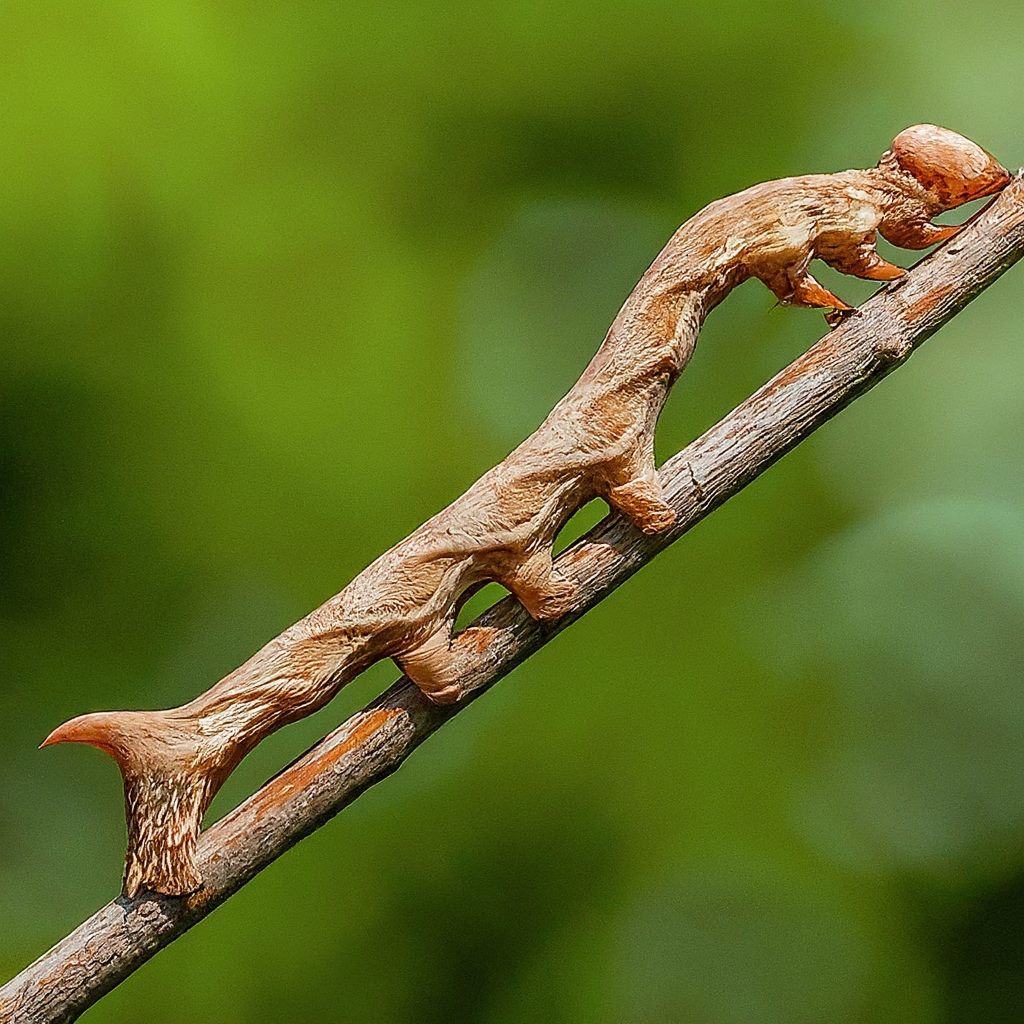
Curved-toothed Geometer Moth Caterpillar
Scientific Name: Eutrapela clemataria
Habitat: Curved-toothed Geometer Moth Caterpillars inhabit deciduous forests, woodlands, and suburban areas across North America, where their host plants are commonly found.
Description: These caterpillars have a slender body with distinctive curved teeth on the thorax, giving them a unique appearance. They are typically green or brown with subtle markings.
Diet: Curved-toothed Geometer Moth Caterpillars feed on the leaves of various hardwood trees, including oaks, maples, and birches, consuming the foliage as they grow.
Host Plants: Various hardwood trees serve as host plants for the Curved-toothed Geometer Moth Caterpillar, providing ample food sources throughout their development.
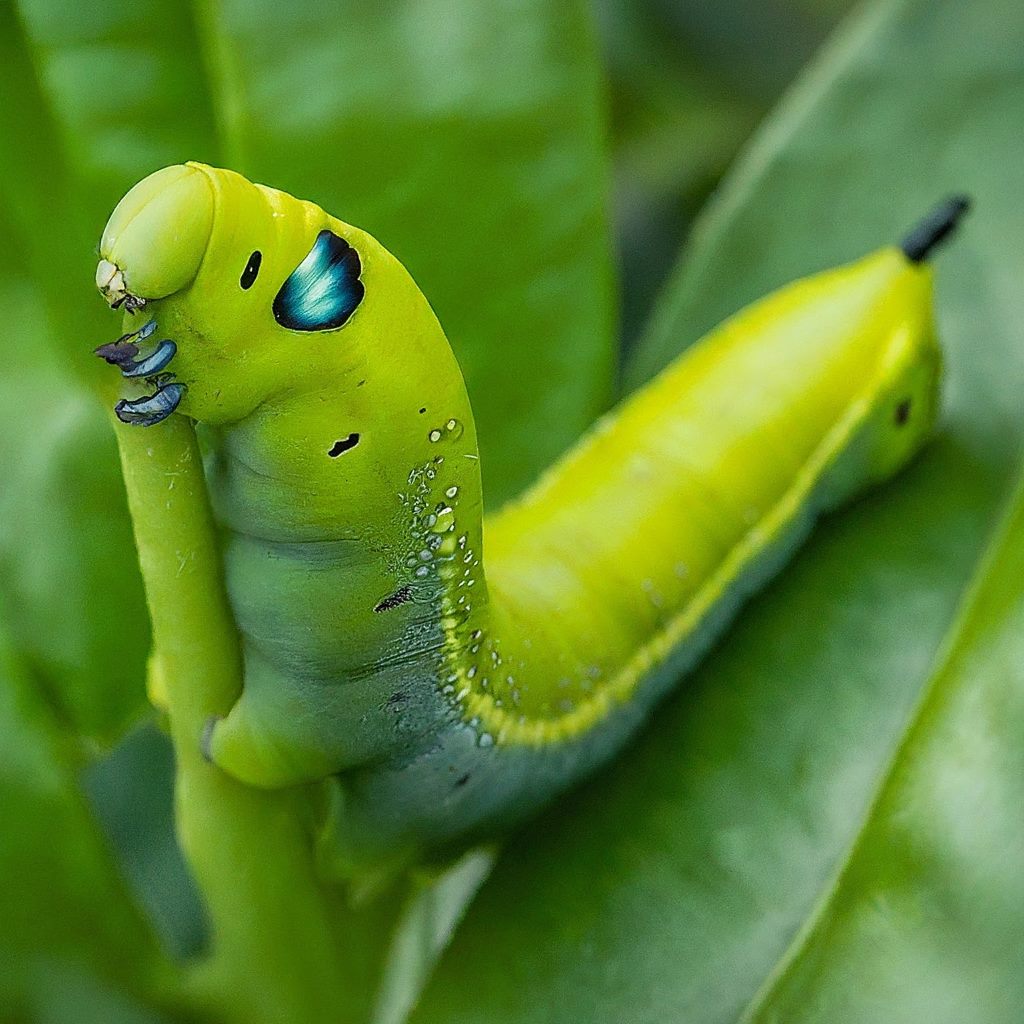
Dark-spotted Palthis Caterpillar
Scientific Name: Palthis angulalis
Habitat: Dark-spotted Palthis Caterpillars inhabit a variety of habitats, including grasslands, meadows, and agricultural areas, where their host plants are commonly found.
Description: These caterpillars are relatively small and inconspicuous, featuring a brown coloration with dark spots scattered along their bodies. They have a cylindrical shape and move with a looping or crawling motion.
Diet: Dark-spotted Palthis Caterpillars feed on the leaves of various herbaceous plants, including grasses, sedges, and wildflowers, consuming the foliage as they grow.
Host Plants: Their diet includes a diverse array of herbaceous plants, making them adaptable to different habitats and ecosystems.
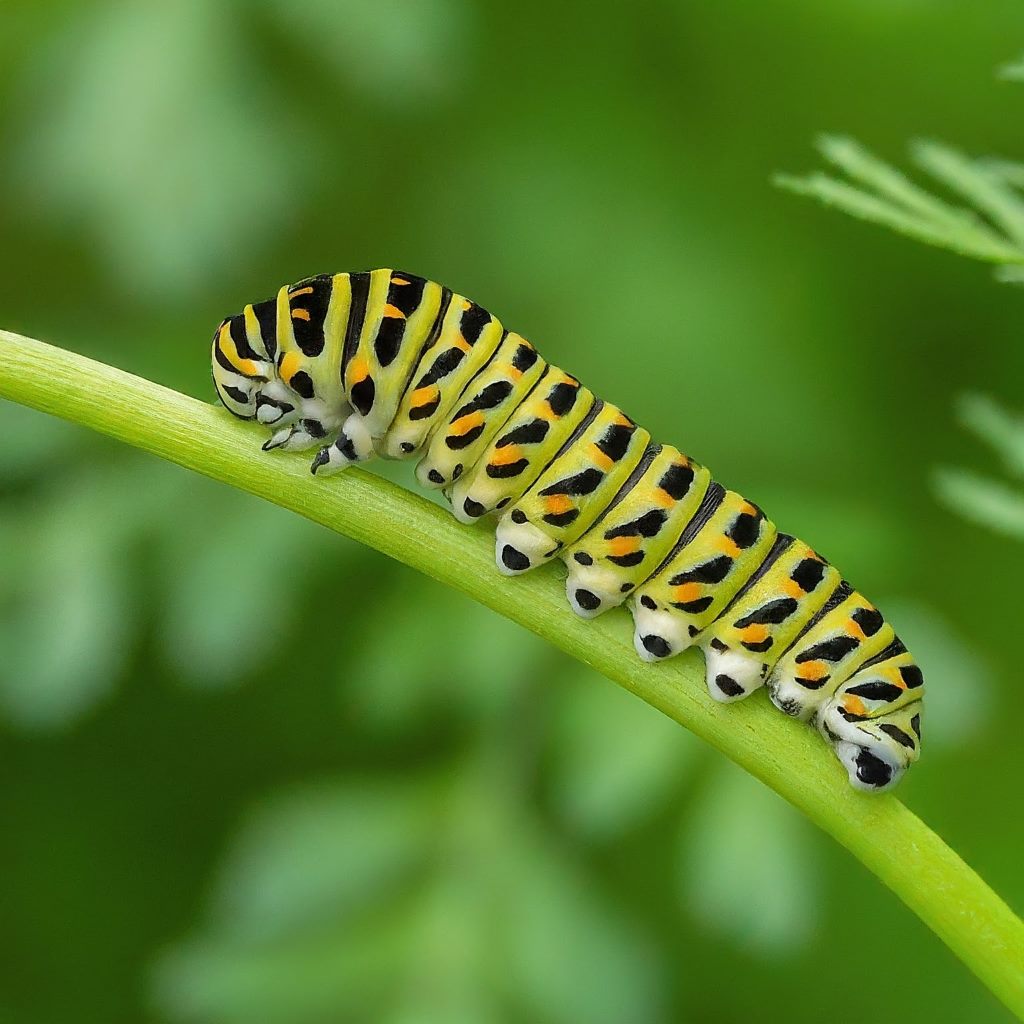
Eastern Tiger Swallowtail Caterpillar
Scientific Name: Papilio glaucus
Habitat: Eastern Tiger Swallowtail Caterpillars inhabit deciduous forests, woodlands, and suburban areas across North America, where their host plants are commonly found.
Description: These caterpillars are strikingly colored, featuring a green body with large, false eyespots on their thorax and yellow accents along their sides. They have a cylindrical shape and move with a looping or crawling motion.
Diet: Eastern Tiger Swallowtail Caterpillars feed on the leaves of various trees, including cherry (Prunus spp.), birch (Betula spp.), and tulip tree (Liriodendron tulipifera), consuming the foliage as they grow.
Host Plants: Various trees, including cherry, birch, and tulip tree, serve as host plants for the Eastern Tiger Swallowtail Caterpillar, providing ample food sources throughout their development.
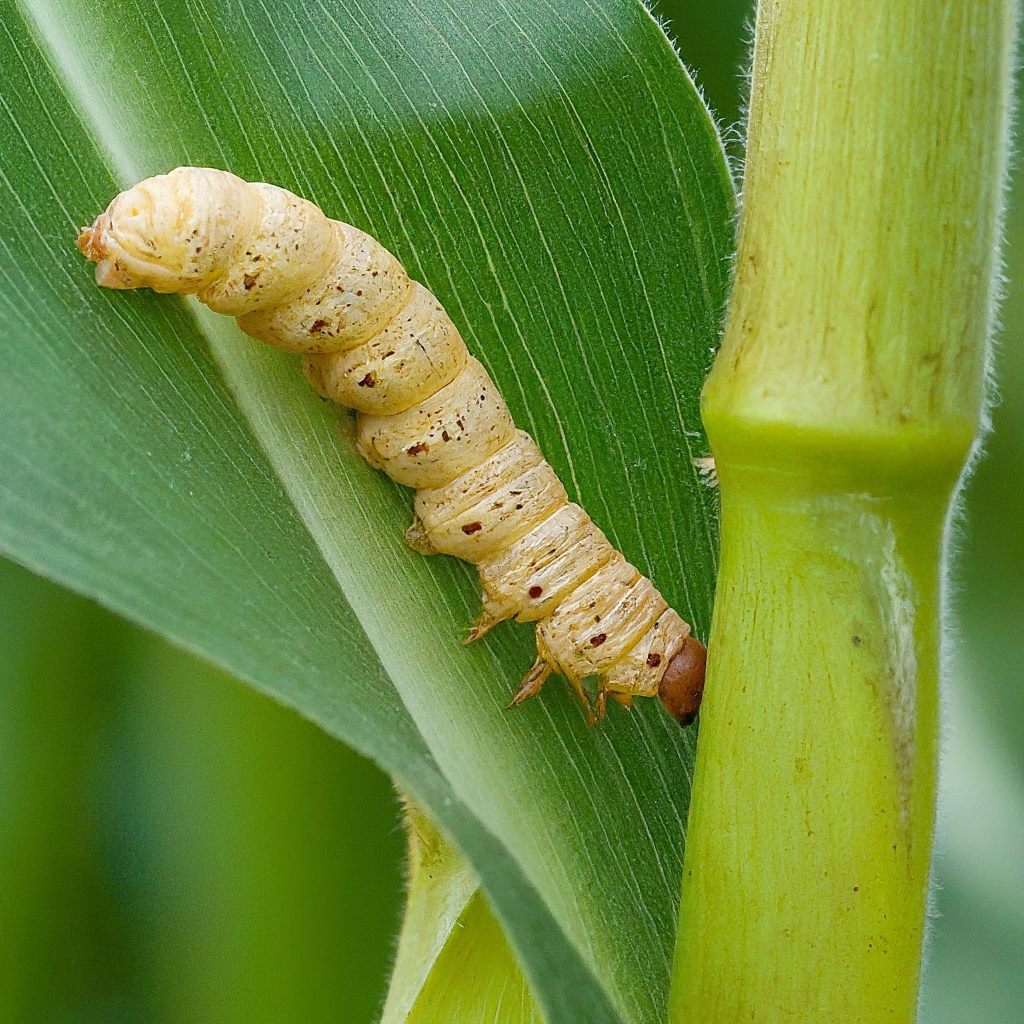
European Corn Borer Caterpillar
Scientific Name: Ostrinia nubilalis
Habitat: European Corn Borer Caterpillars are primarily found in agricultural areas, including cornfields, where their host plants are cultivated.
Description: These caterpillars are relatively small and inconspicuous, featuring a pinkish body with dark spots and a distinctive head capsule. They have a cylindrical shape and move with a looping or crawling motion.
Diet: European Corn Borer Caterpillars are notorious pests of corn and various other crops, feeding on the foliage, stems, and ears of the plants.
Host Plants: Corn (Zea mays) is the primary host plant for the European Corn Borer Caterpillar, but they may also feed on other crops and weeds within their range.
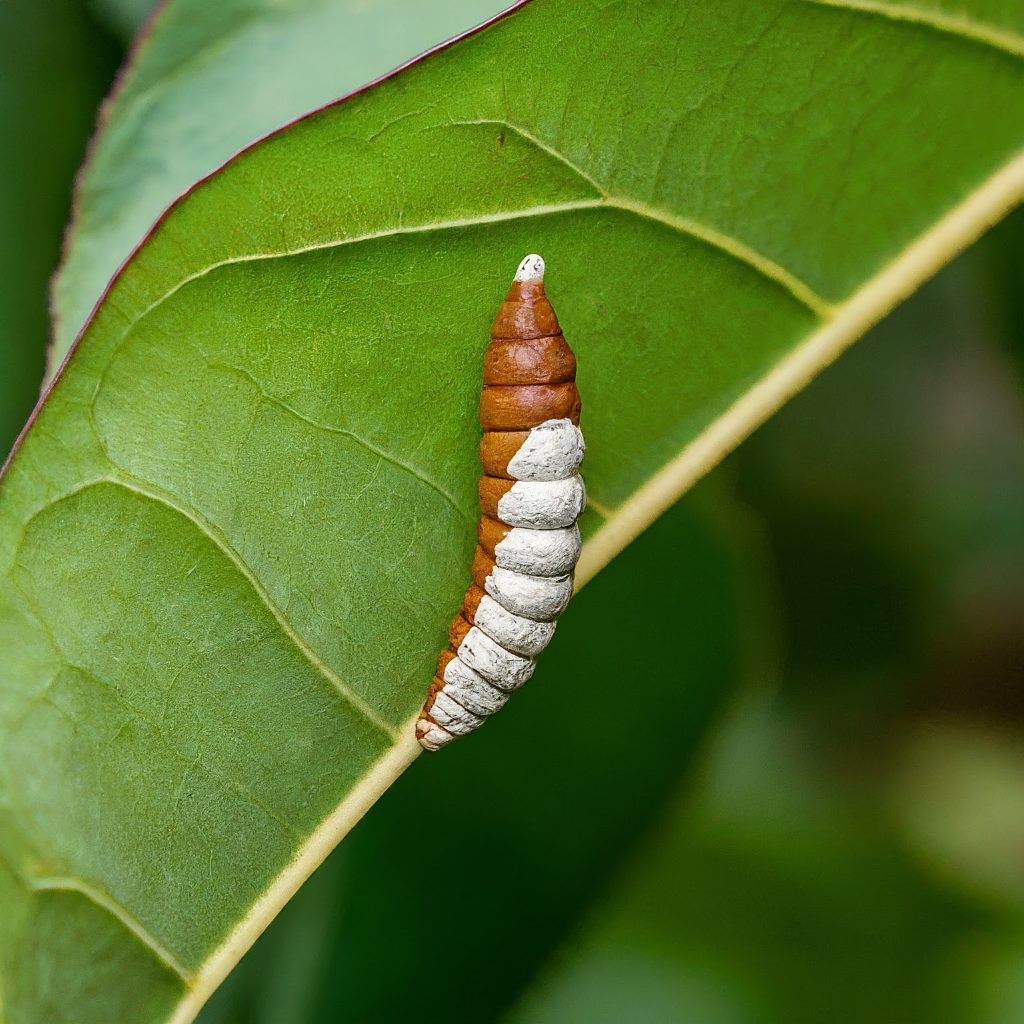
Exposed Bird Dropping Moth Caterpillar
Scientific Name: Cerma cerintha
Habitat: Exposed Bird Dropping Moth Caterpillars inhabit a variety of habitats, including forests, woodlands, and urban areas, where their host plants grow abundantly.
Description: These caterpillars have a unique appearance, resembling bird droppings with their dark coloration and subtle patterns. This camouflage helps them evade predators.
Diet: Exposed Bird Dropping Moth Caterpillars feed on the leaves of various trees and shrubs, consuming the foliage as they grow.
Host Plants: Various trees and shrubs serve as host plants for the Exposed Bird Dropping Moth Caterpillar, providing ample food sources throughout their development.
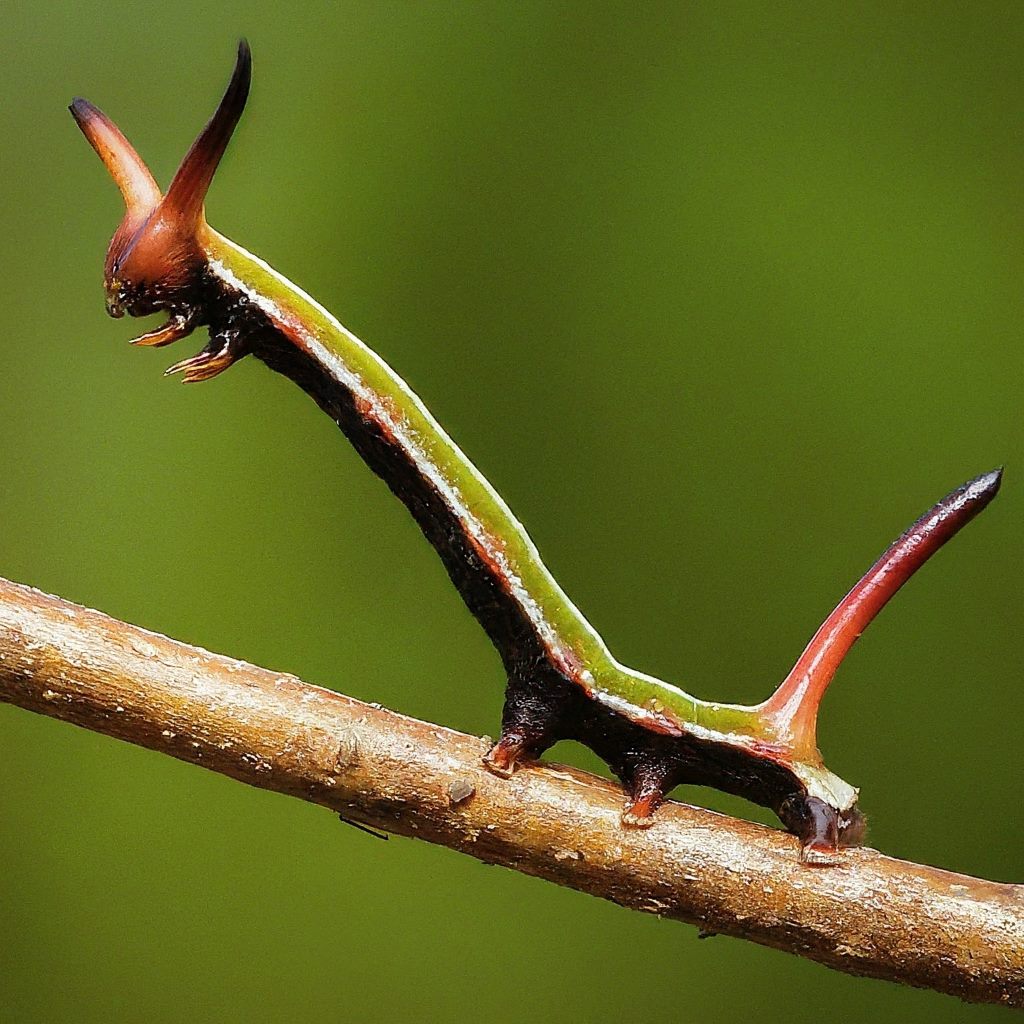
Horned Spanworm Caterpillar
Scientific Name: Nematocampa resistaria
Habitat: Horned Spanworm Caterpillars inhabit deciduous forests, woodlands, and suburban areas across North America, where their host plants are commonly found.
Description: These caterpillars are named for the distinctive “horns” on their head capsules, which give them a unique appearance. They are typically green with darker markings and patterns.
Diet: Horned Spanworm Caterpillars feed on the leaves of various deciduous trees, including oaks, maples, and birches, consuming the foliage as they grow.
Host Plants: Various deciduous trees serve as host plants for the Horned Spanworm Caterpillar, providing ample food sources throughout their development.
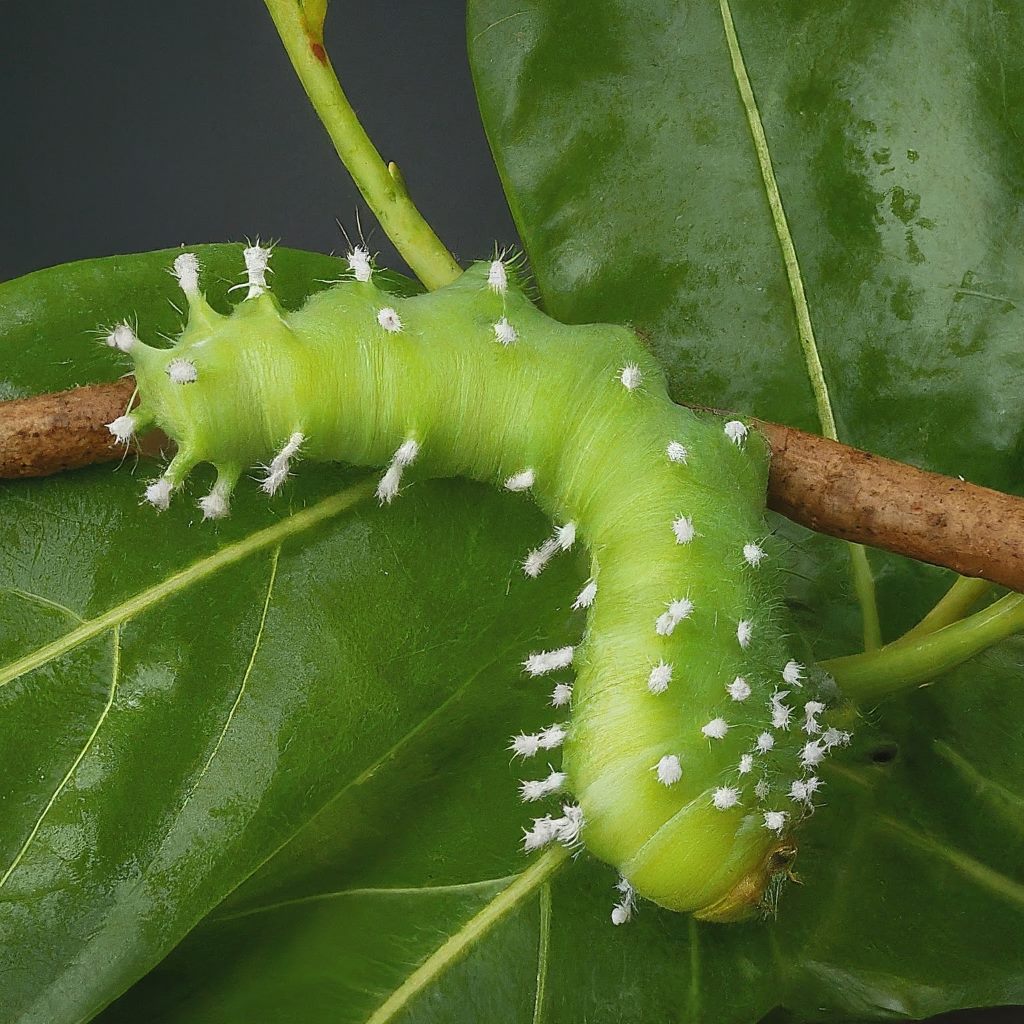
Imperial Moth Caterpillar
Scientific Name: Eacles imperialis
Habitat: Imperial Moth Caterpillars inhabit deciduous forests, woodlands, and suburban areas across North America, where their host plants are commonly found.
Description: These caterpillars are large and robust, featuring a striking coloration with green and brown hues. They are adorned with spines along their bodies, which serve as a defense mechanism against predators.
Diet: Imperial Moth Caterpillars feed on the leaves of various trees, including oak (Quercus spp.) and pine (Pinus spp.), consuming the foliage as they grow.
Host Plants: Various trees, including oak and pine, serve as host plants for the Imperial Moth Caterpillar, providing ample food sources throughout their development.
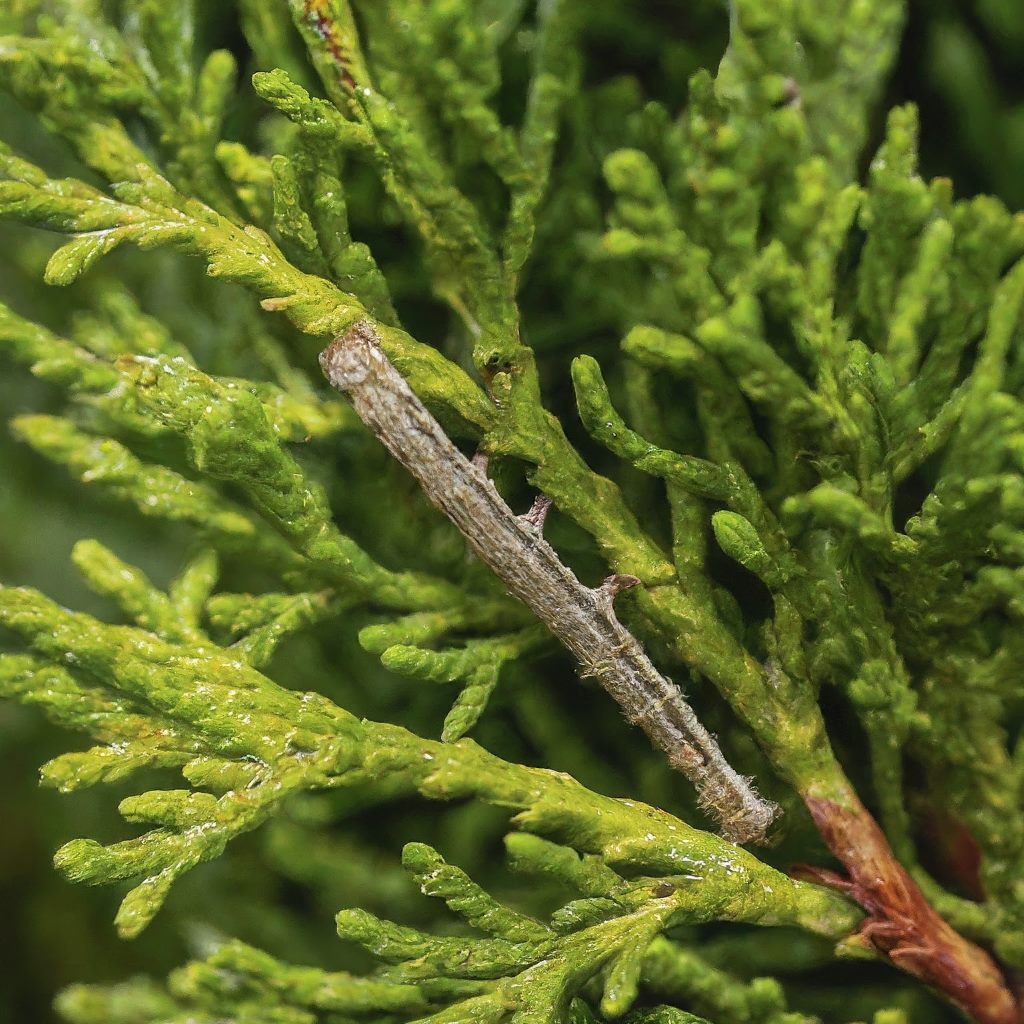
Juniper Geometer Caterpillar
Scientific Name: Patalene olyzonaria
Habitat: Juniper Geometer Caterpillars inhabit coniferous forests, woodlands, and suburban areas across North America, where their host plants grow abundantly.
Description: These caterpillars have a green body with intricate patterning and markings, providing camouflage among the foliage of juniper and cedar trees.
Diet: Juniper Geometer Caterpillars feed on the foliage of juniper (Juniperus spp.) and cedar (Cedrus spp.) trees, consuming the needles and tender shoots as they grow.
Host Plants: Juniper and cedar trees serve as the primary host plants for the Juniper Geometer Caterpillar, providing ample food sources throughout their development.
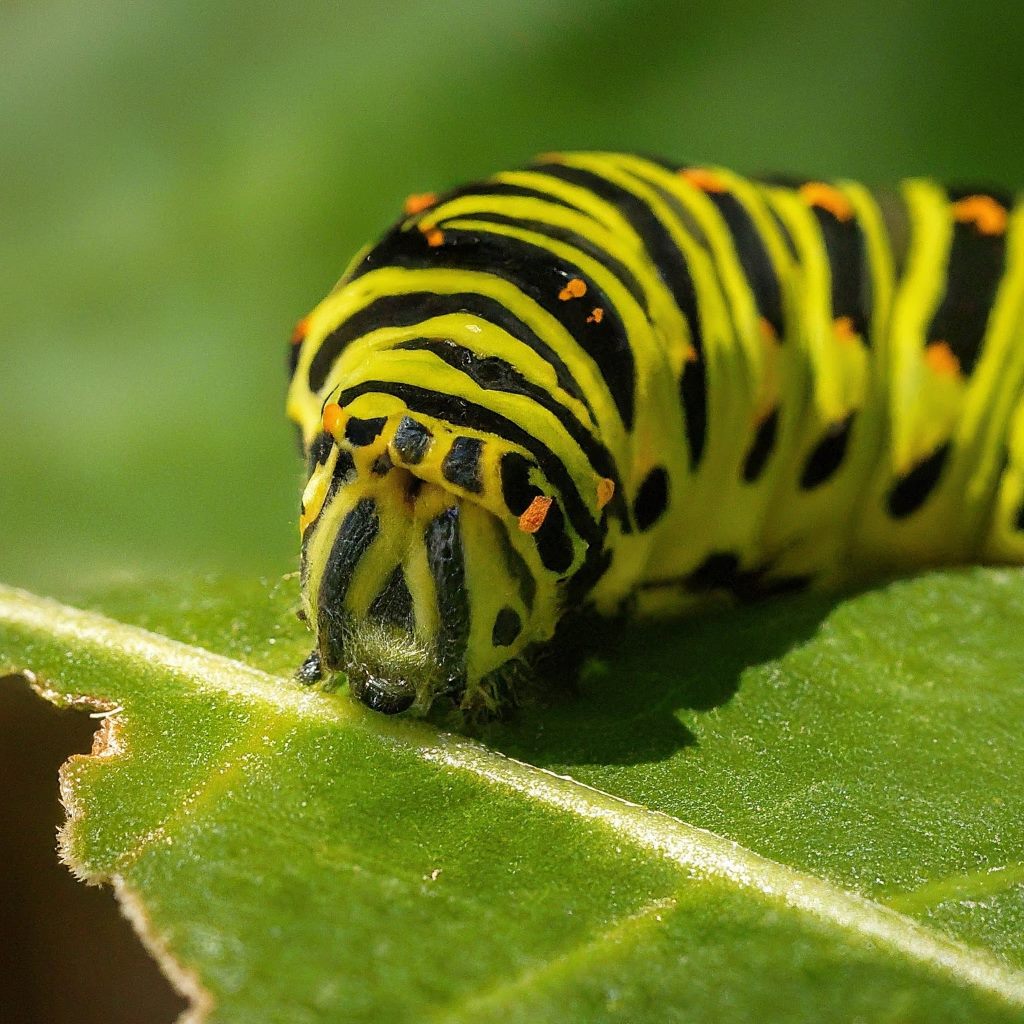
Large Yellow Underwing Caterpillar
Scientific Name: Noctua pronuba
Habitat: Large Yellow Underwing Caterpillars inhabit a variety of habitats, including grasslands, meadows, and agricultural areas, where their host plants are commonly found.
Description: These caterpillars are brownish with yellowish markings and fine hairs along their bodies. They have a cylindrical shape and move with a looping or crawling motion.
Diet: Large Yellow Underwing Caterpillars feed on the leaves of various herbaceous plants, including grasses, nettles, and clovers, consuming the foliage as they grow.
Host Plants: Various herbaceous plants serve as host plants for the Large Yellow Underwing Caterpillar, providing ample food sources throughout their development.
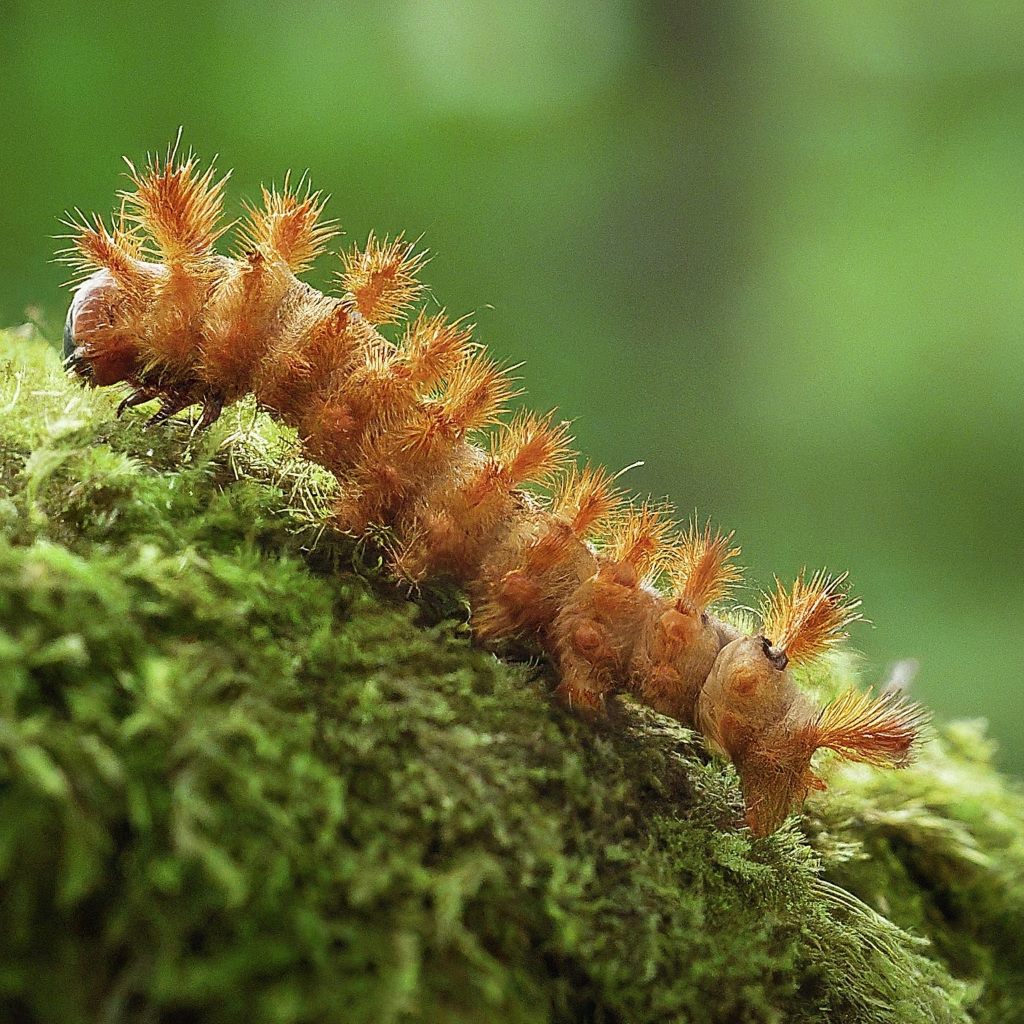
Little Wood Satyr Caterpillar
Scientific Name: Megisto cymela
Habitat: Little Wood Satyr Caterpillars inhabit grasslands, meadows, and woodland edges across North America, where their host plants are commonly found.
Description: These caterpillars are small and inconspicuous, featuring a brown coloration with subtle markings and patterns. They have a cylindrical shape and move with a looping or crawling motion.
Diet: Little Wood Satyr Caterpillars feed on the leaves of grasses and sedges, consuming the foliage as they grow.
Host Plants: Grasses and sedges serve as the primary host plants for the Little Wood Satyr Caterpillar, providing ample food sources throughout their development.
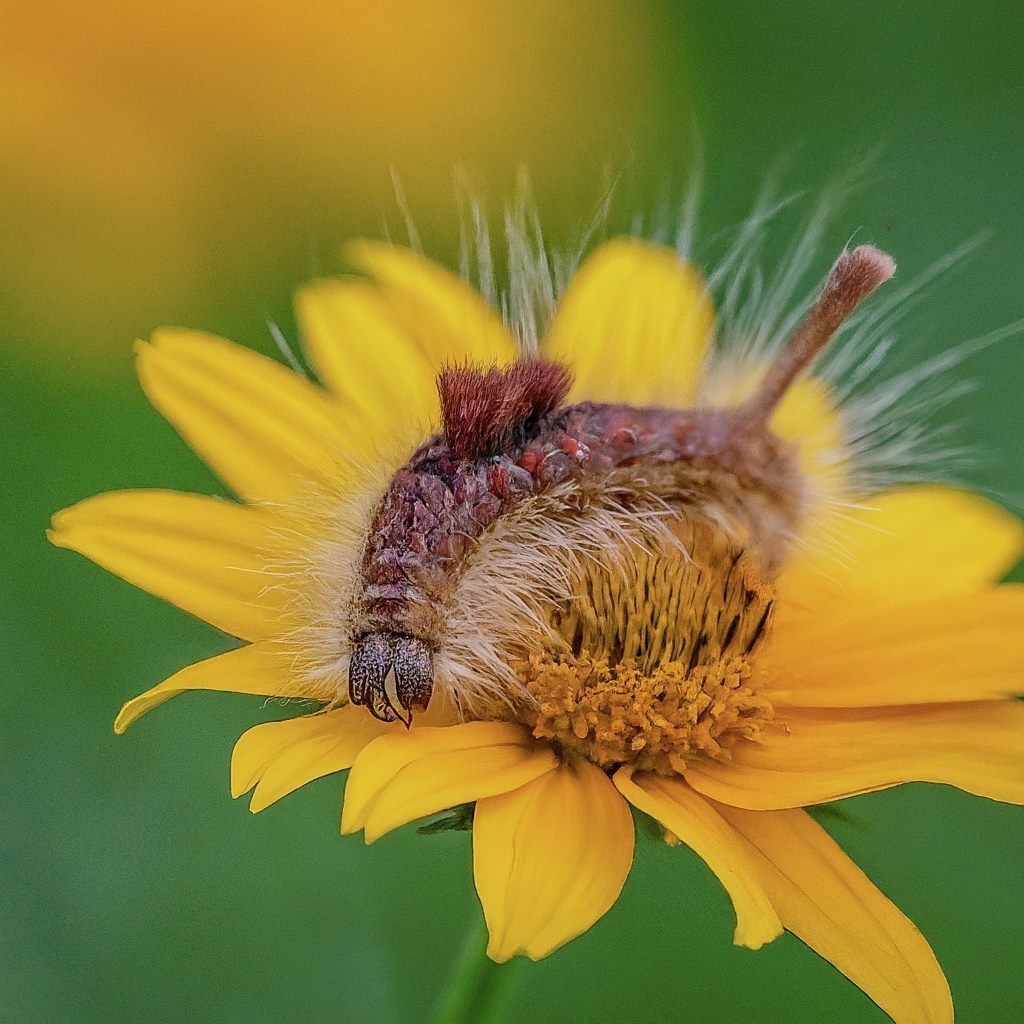
Lunate Zale Moth Caterpillar
Scientific Name: Zale lunata
Habitat: Lunate Zale Moth Caterpillars inhabit deciduous forests, woodlands, and suburban areas across North America, where their host plants are commonly found.
Description: These caterpillars have a striking appearance, featuring lunate-shaped markings along their bodies. They are typically brown with darker patterns and markings.
Diet: Lunate Zale Moth Caterpillars feed on the leaves of various deciduous trees, including oaks, maples, and birches, consuming the foliage as they grow.
Host Plants: Various deciduous trees serve as host plants for the Lunate Zale Moth Caterpillar, providing ample food sources throughout their development.
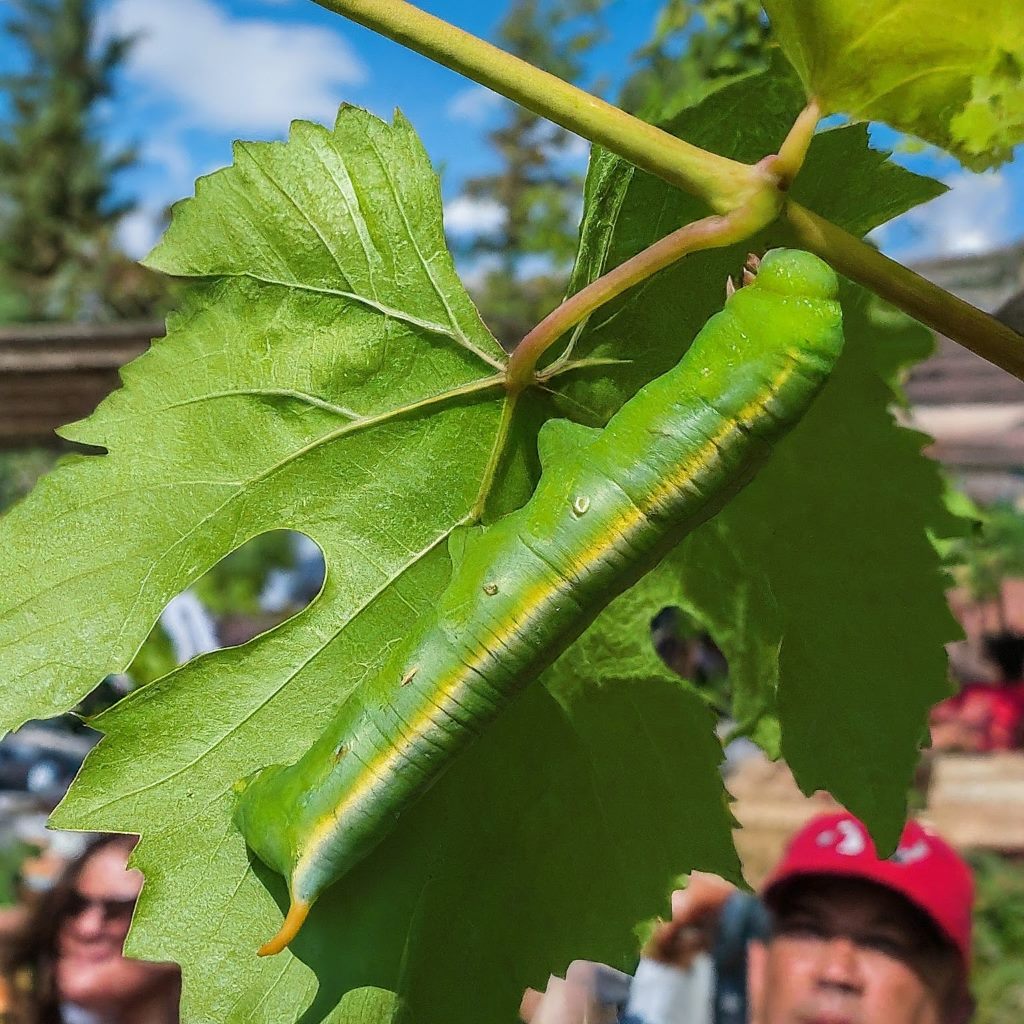
Nessus Sphinx Caterpillar
Scientific Name: Amphion floridensis
Habitat: Nessus Sphinx Caterpillars inhabit a variety of habitats, including forests, woodlands, and suburban areas, where their host plants grow abundantly.
Description: These caterpillars have a green body with diagonal white stripes along their sides and a distinctive horn at the rear end. They are relatively large and robust compared to other species.
Diet: Nessus Sphinx Caterpillars feed on the leaves of various plants, including grape (Vitis spp.) and Virginia creeper (Parthenocissus quinquefolia) vines, as well as other herbaceous plants.
Host Plants: Grape and Virginia creeper vines serve as the primary host plants for the Nessus Sphinx Caterpillar, providing ample food sources throughout their development.
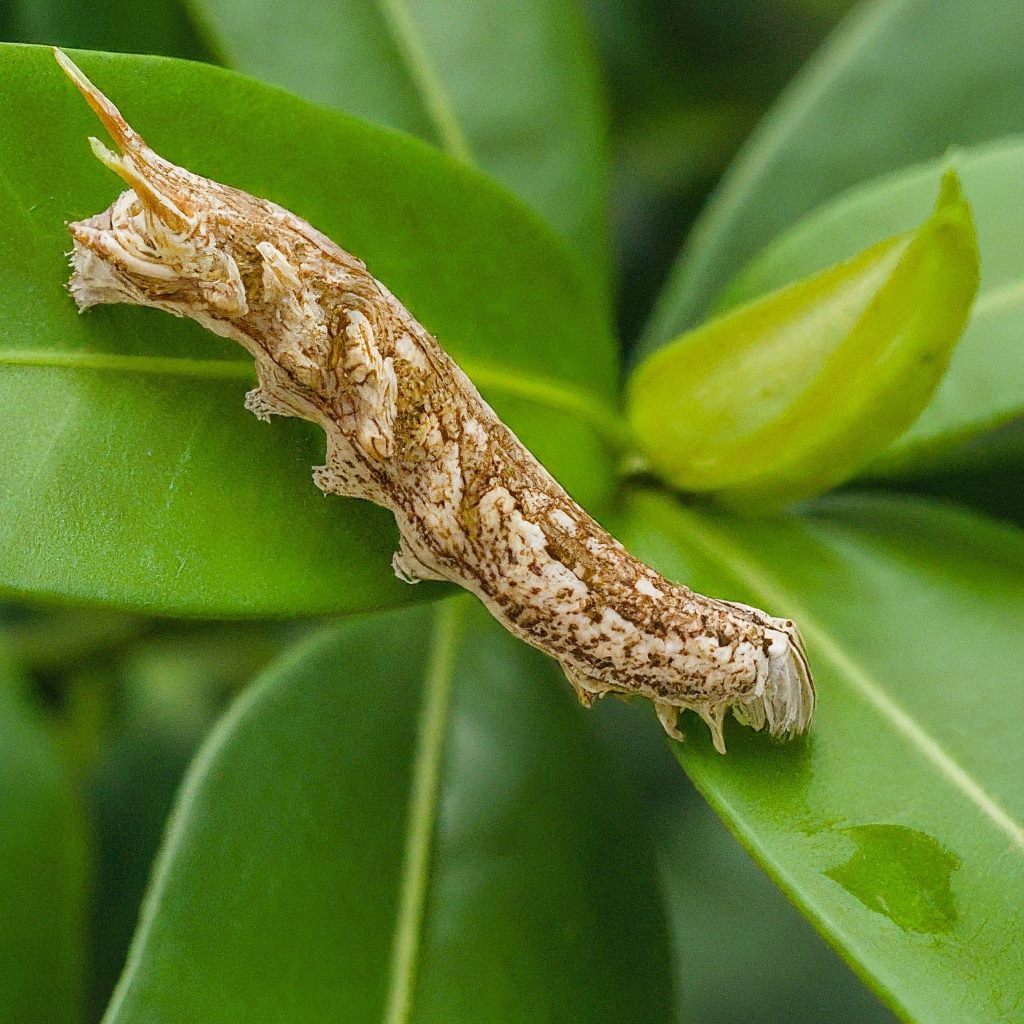
One-spotted Variant Caterpillar
Scientific Name: Apantesis phalerata
Habitat: One-spotted Variant Caterpillars inhabit a variety of habitats, including grasslands, meadows, and agricultural areas, where their host plants grow abundantly.
Description: These caterpillars have a black body with distinct white spots and bands along their bodies. They have a cylindrical shape and move with a looping or crawling motion.
Diet: One-spotted Variant Caterpillars feed on the leaves of various plants, including milkweed (Asclepias spp.) and clover (Trifolium spp.), as well as other herbaceous plants.
Host Plants: Various plants, including milkweed and clover, serve as host plants for the One-spotted Variant Caterpillar, providing ample food sources throughout their development.
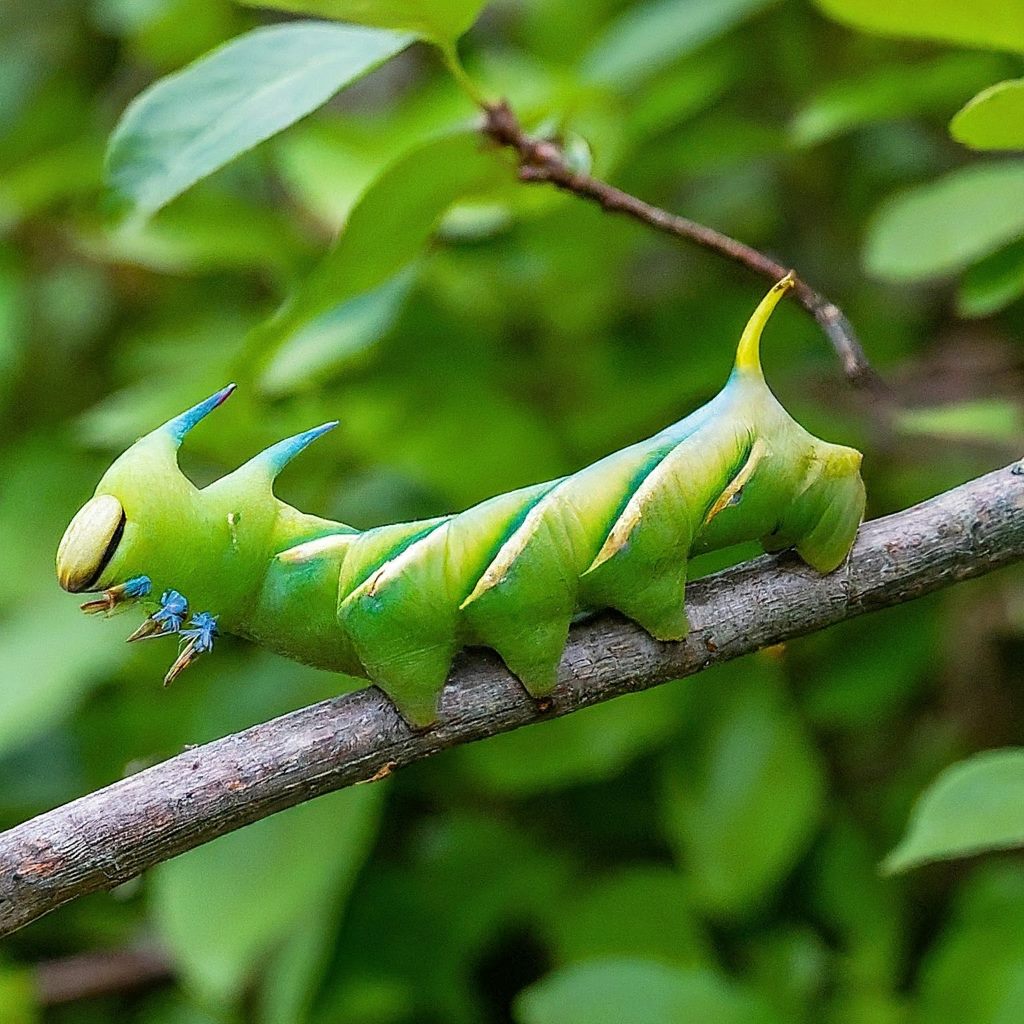
Pandora Sphinx Moth Caterpillar
Scientific Name: Eumorpha pandorus
Habitat: Pandora Sphinx Moth Caterpillars inhabit a variety of habitats, including forests, woodlands, and suburban areas, where their host plants grow abundantly.
Description: These caterpillars have a green body with a distinctive eyespot on their thorax, which serves as a defense mechanism against predators. They are relatively large and robust compared to other species.
Diet: Pandora Sphinx Moth Caterpillars feed on the leaves of various vines, including grapevine (Vitis spp.), Virginia creeper (Parthenocissus quinquefolia), and other members of the Vitaceae family.
Host Plants: Grapevine, Virginia creeper, and other vines serve as host plants for the Pandora Sphinx Moth Caterpillar, providing ample food sources throughout their development.
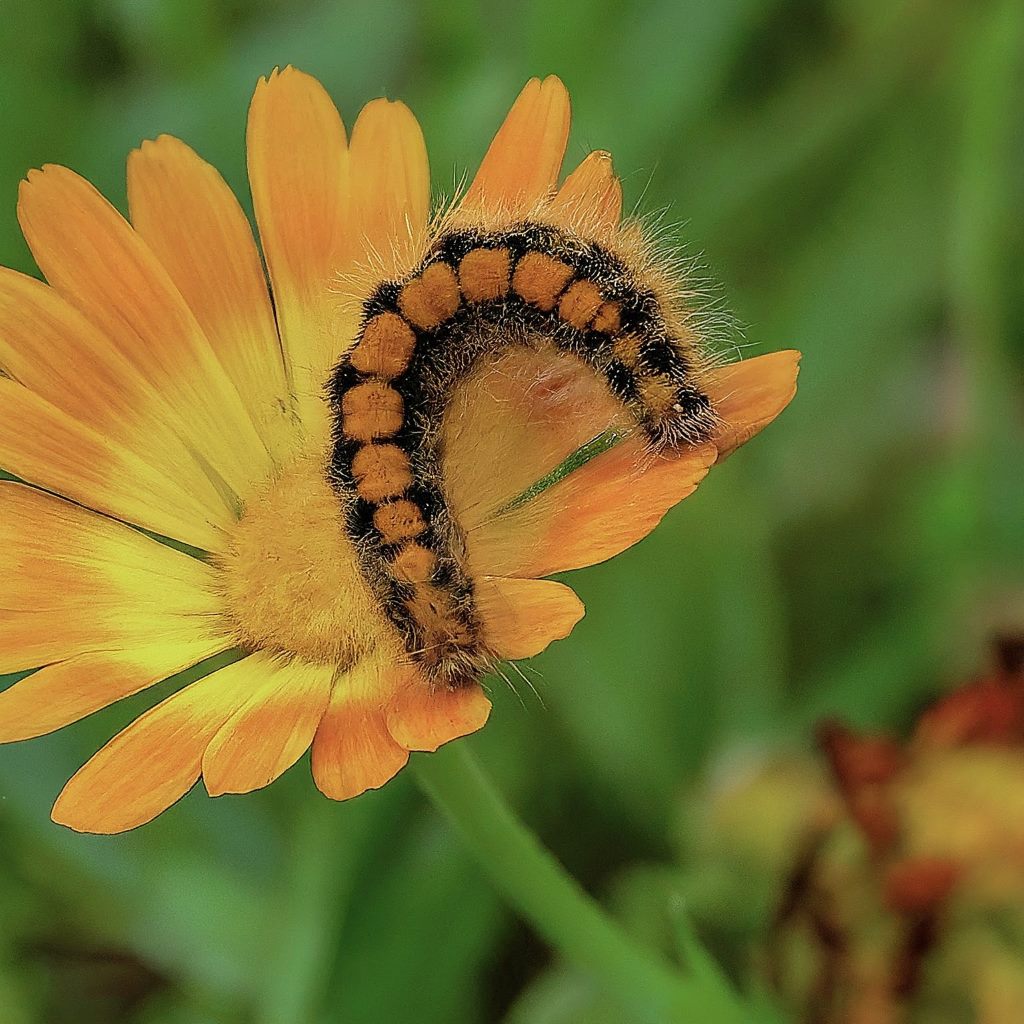
Pearl Crescent Caterpillar
Scientific Name: Phyciodes tharos
Habitat: Pearl Crescent Caterpillars inhabit a variety of habitats, including grasslands, meadows, and woodland edges, where their host plants grow abundantly.
Description: These caterpillars have a black body with spines and white spots along their bodies. They have a cylindrical shape and move with a looping or crawling motion.
Diet: Pearl Crescent Caterpillars feed on the leaves of various plants, including asters (Aster spp.) and sunflowers (Helianthus spp.), as well as other herbaceous plants.
Host Plants: Various plants, including asters and sunflowers, serve as host plants for the Pearl Crescent Caterpillar, providing ample food sources throughout their development.
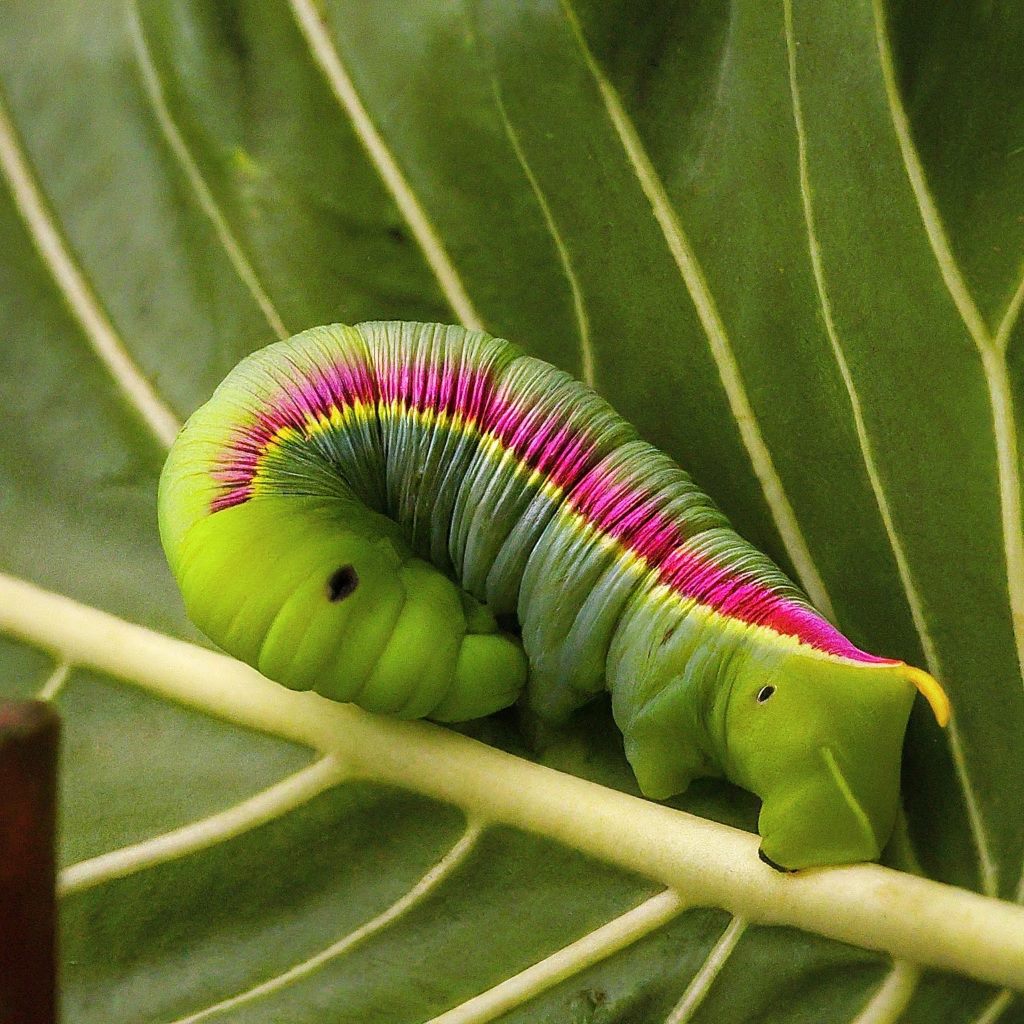
Pink-Spotted Hawkmoth Caterpillar
Scientific Name: Agrius cingulata
Habitat: Pink-Spotted Hawkmoth Caterpillars inhabit a variety of habitats, including grasslands, meadows, and agricultural areas, where their host plants grow abundantly.
Description: These caterpillars have a large and robust body with pink markings and a distinctive horn at the rear end. They are relatively conspicuous compared to other species.
Diet: Pink-Spotted Hawkmoth Caterpillars feed on the leaves of various plants, including sweet potatoes (Ipomoea batatas) and other members of the Convolvulaceae family.
Host Plants: Various plants, including sweet potatoes, serve as host plants for the Pink-Spotted Hawkmoth Caterpillar, providing ample food sources throughout their development.
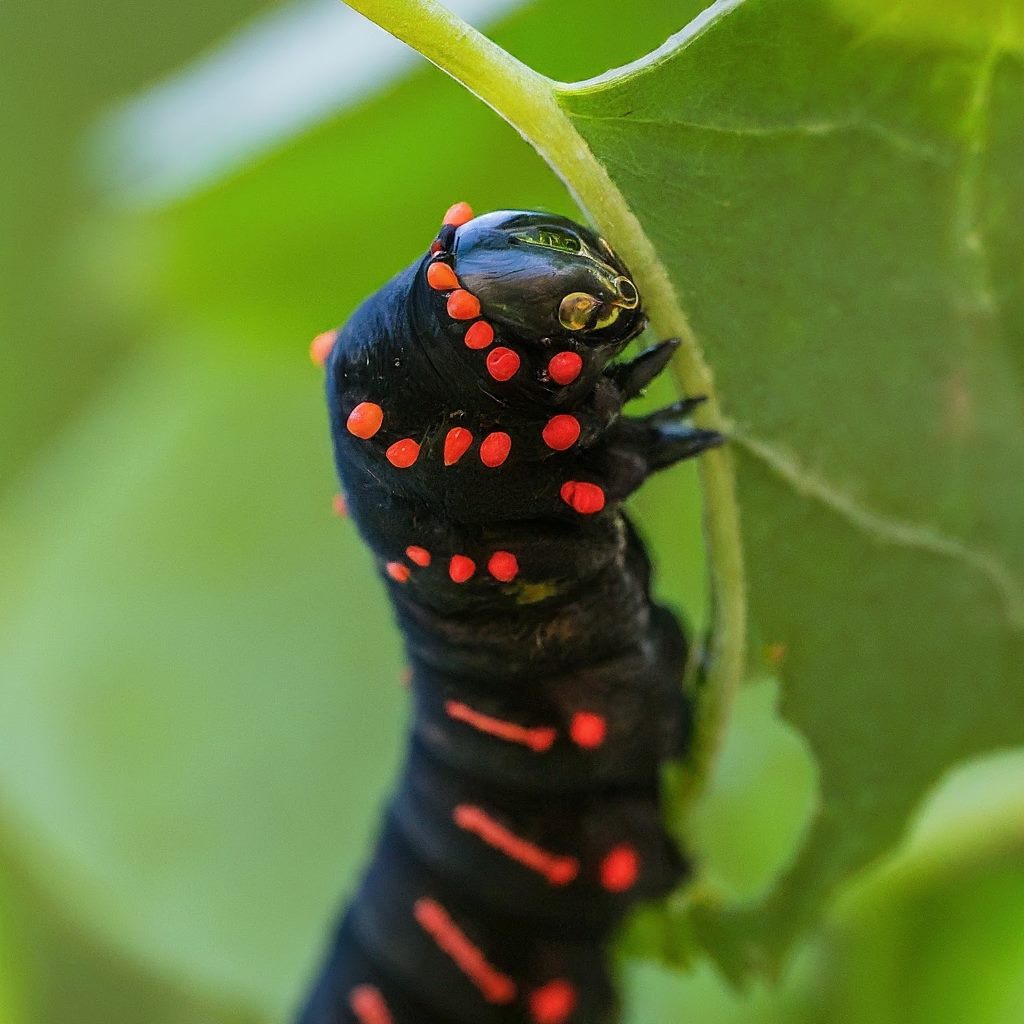
Pipevine Swallowtail Caterpillar
Scientific Name: Battus philenor
Habitat: Pipevine Swallowtail Caterpillars inhabit a variety of habitats, including forests, woodlands, and suburban areas, where their host plants grow abundantly.
Description: These caterpillars have a black body with red-orange bands and spines along their bodies. They have a cylindrical shape and move with a looping or crawling motion.
Diet: Pipevine Swallowtail Caterpillars feed on the leaves of pipevine plants (Aristolochia spp.), consuming the foliage as they grow.
Host Plants: Pipevine plants (Aristolochia spp.) serve as the primary host plants for the Pipevine Swallowtail Caterpillar, providing ample food sources throughout their development.
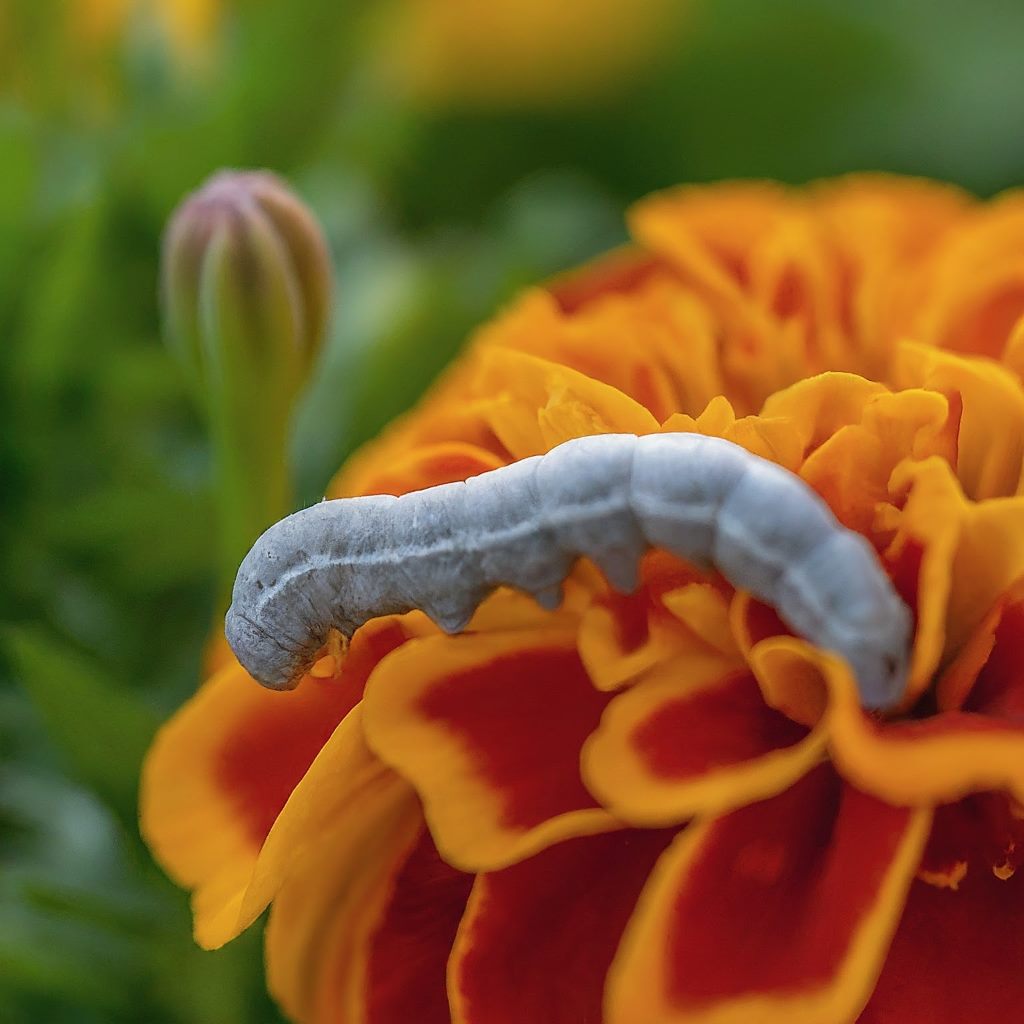
Porcelain Gray Caterpillar
Scientific Name: Protoboarmia porcelaria
Habitat: Porcelain Gray Caterpillars inhabit a variety of habitats, including forests, woodlands, and suburban areas, where their host plants grow abundantly.
Description: These caterpillars have a gray body with intricate patterning and markings, providing camouflage among the foliage of various trees and shrubs.
Diet: Porcelain Gray Caterpillars feed on the leaves of various trees and shrubs, consuming the foliage as they grow.
Host Plants: Various trees and shrubs serve as host plants for the Porcelain Gray Caterpillar, providing ample food sources throughout their development.
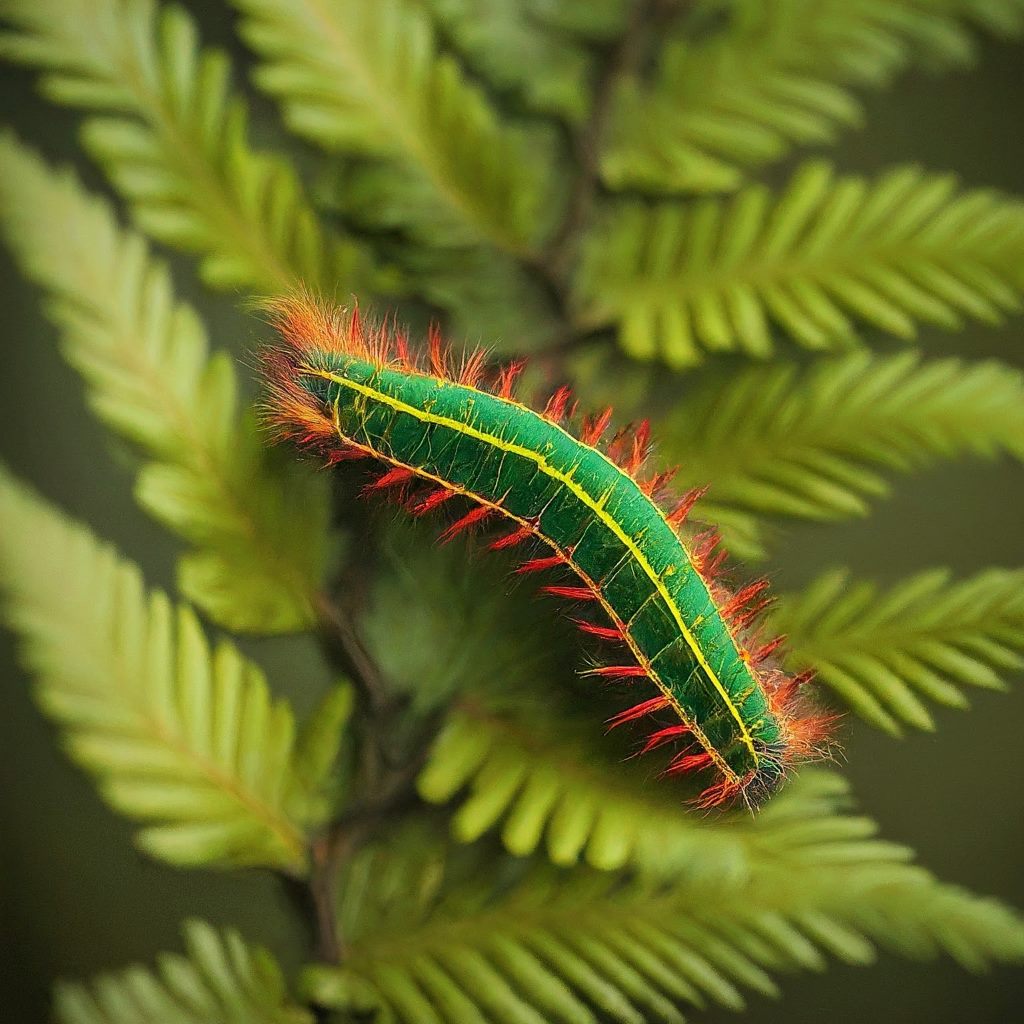
Red-fringed Emerald Caterpillar
Scientific Name: Synchlora aerata
Habitat: Red-fringed Emerald Caterpillars inhabit a variety of habitats, including forests, woodlands, and suburban areas, where their host plants grow abundantly.
Description: These caterpillars have a green body with red markings and fringed edges along their bodies. They have a cylindrical shape and move with a looping or crawling motion.
Diet: Red-fringed Emerald Caterpillars feed on the leaves of various plants, including cherry (Prunus spp.) and rose (Rosa spp.), as well as other herbaceous plants.
Host Plants: Various plants, including cherry and rose, serve as host plants for the Red-fringed Emerald Caterpillar, providing ample food sources throughout their development.
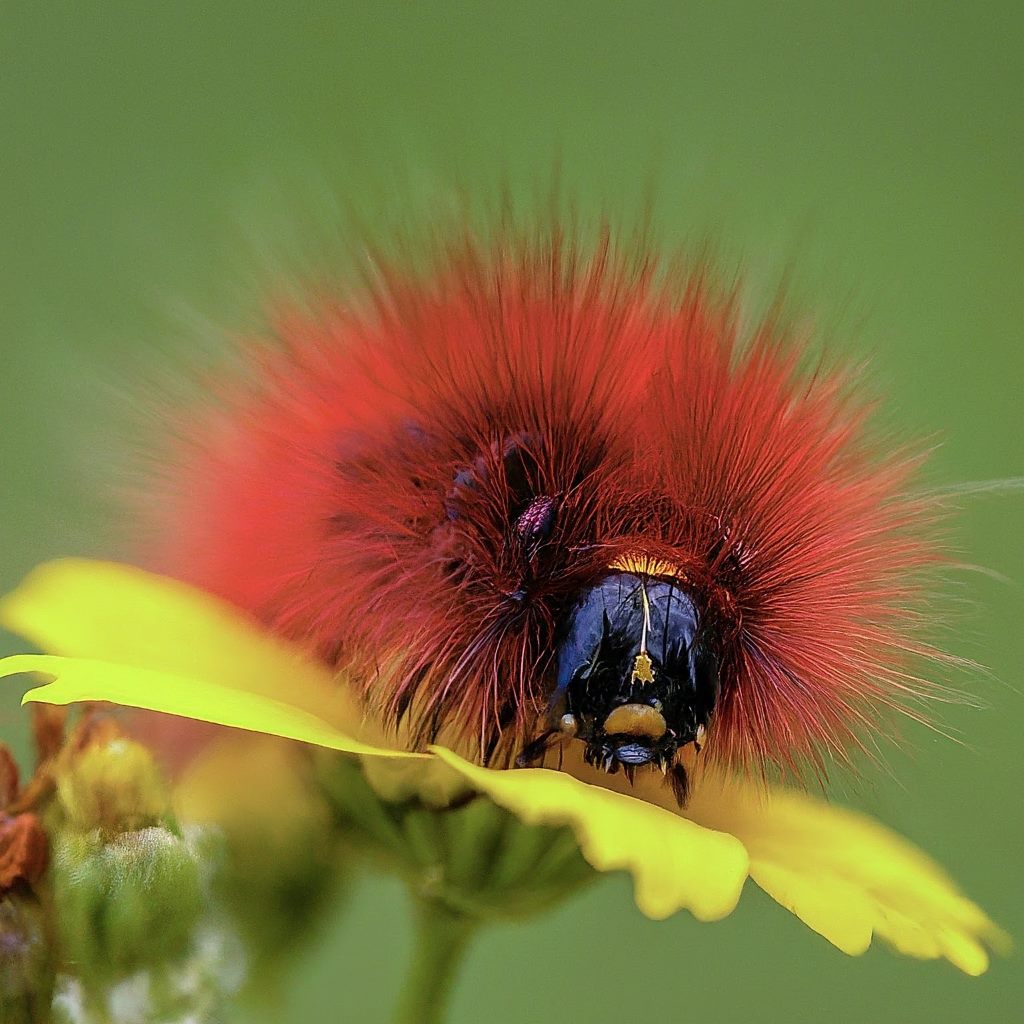
Ruby Tiger Moth Caterpillar
Scientific Name: Phragmatobia fuliginosa
Habitat: Ruby Tiger Moth Caterpillars inhabit a variety of habitats, including grasslands, meadows, and woodland edges, where their host plants grow abundantly.
Description: These caterpillars have a brightly colored body with red and black markings along their bodies. They have a cylindrical shape and move with a looping or crawling motion.
Diet: Ruby Tiger Moth Caterpillars feed on the leaves of various plants, including nettles (Urtica spp.), as well as other herbaceous plants.
Host Plants: Various plants, including nettles, serve as host plants for the Ruby Tiger Moth Caterpillar, providing ample food sources throughout their development.
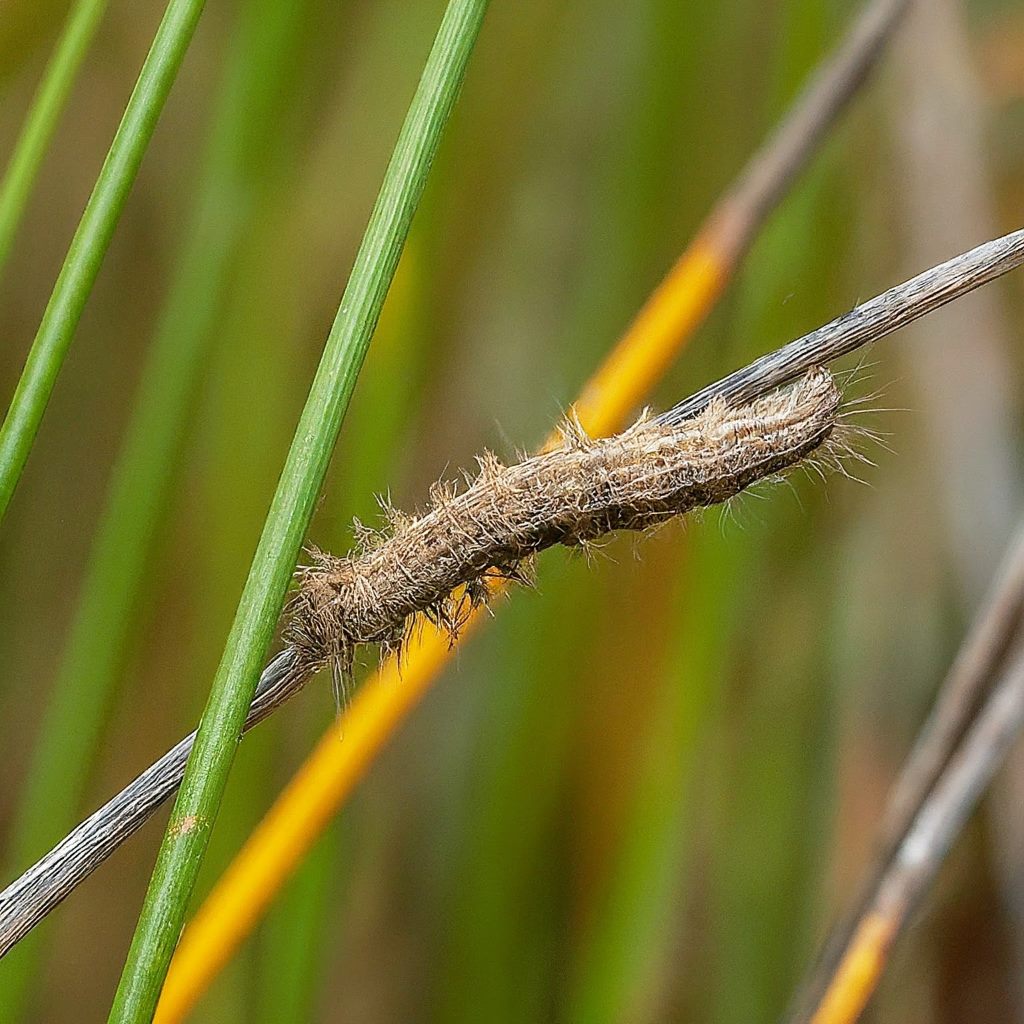
Salt Marsh Caterpillar
Scientific Name: Estigmene acrea
Habitat: Salt Marsh Caterpillars inhabit a variety of habitats, including salt marshes, coastal dunes, and grasslands, where their host plants grow abundantly.
Description: These caterpillars have a distinctive appearance, featuring alternating black and white stripes along their bodies. They have a cylindrical shape and move with a looping or crawling motion.
Diet: Salt Marsh Caterpillars feed on the leaves of various plants, including grasses, sedges, and shrubs, consuming the foliage as they grow.
Host Plants: Various plants, including grasses and shrubs, serve as host plants for the Salt Marsh Caterpillar, providing ample food sources throughout their development.
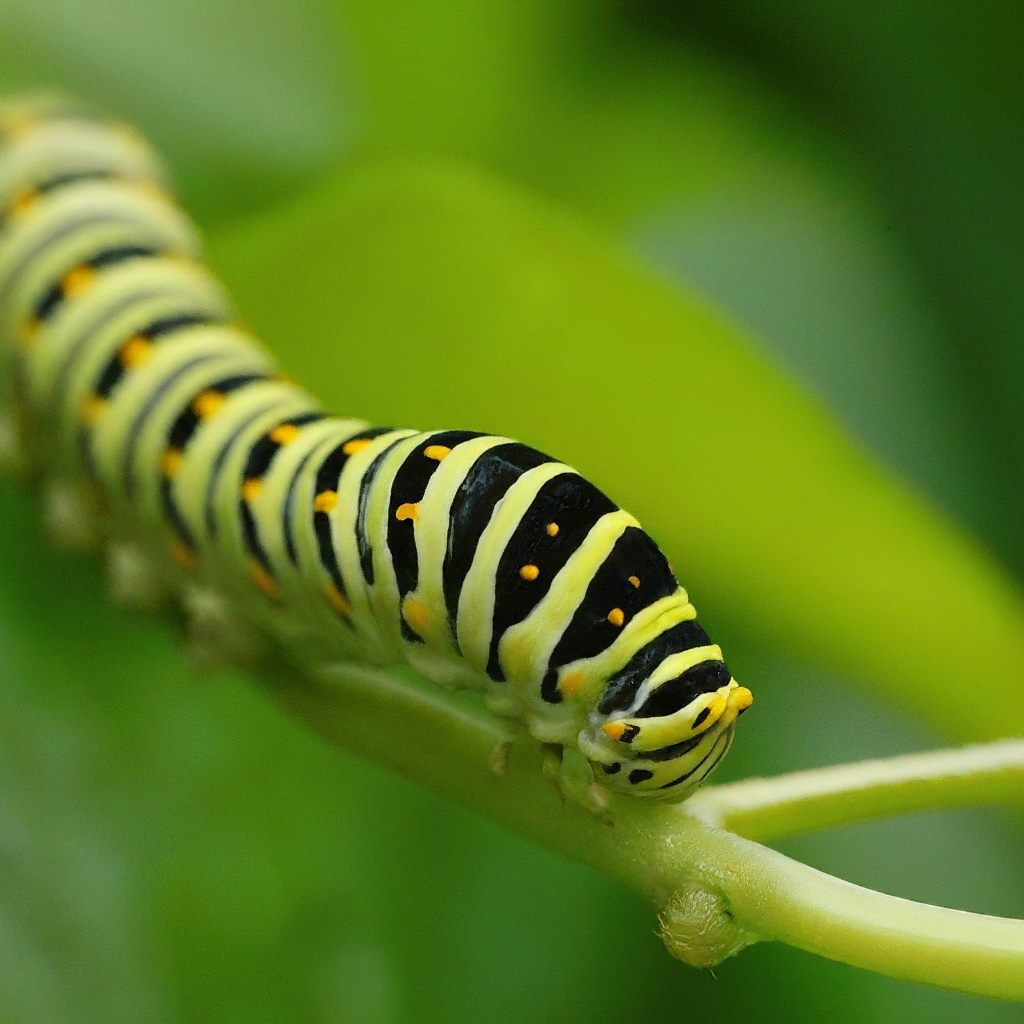
Striped Garden Caterpillar
Scientific Name: Trichordestra legitima
Habitat: Striped Garden Caterpillars inhabit a variety of habitats, including gardens, parks, and agricultural areas, where their host plants grow abundantly.
Description: These caterpillars have a green body with distinct yellow and black stripes along their bodies. They have a cylindrical shape and move with a looping or crawling motion.
Diet: Striped Garden Caterpillars feed on the leaves of various garden plants, including tomatoes (Solanum lycopersicum), peppers (Capsicum spp.), and eggplants (Solanum melongena).
Host Plants: Various garden plants, including tomatoes, serve as host plants for the Striped Garden Caterpillar, providing ample food sources throughout their development.
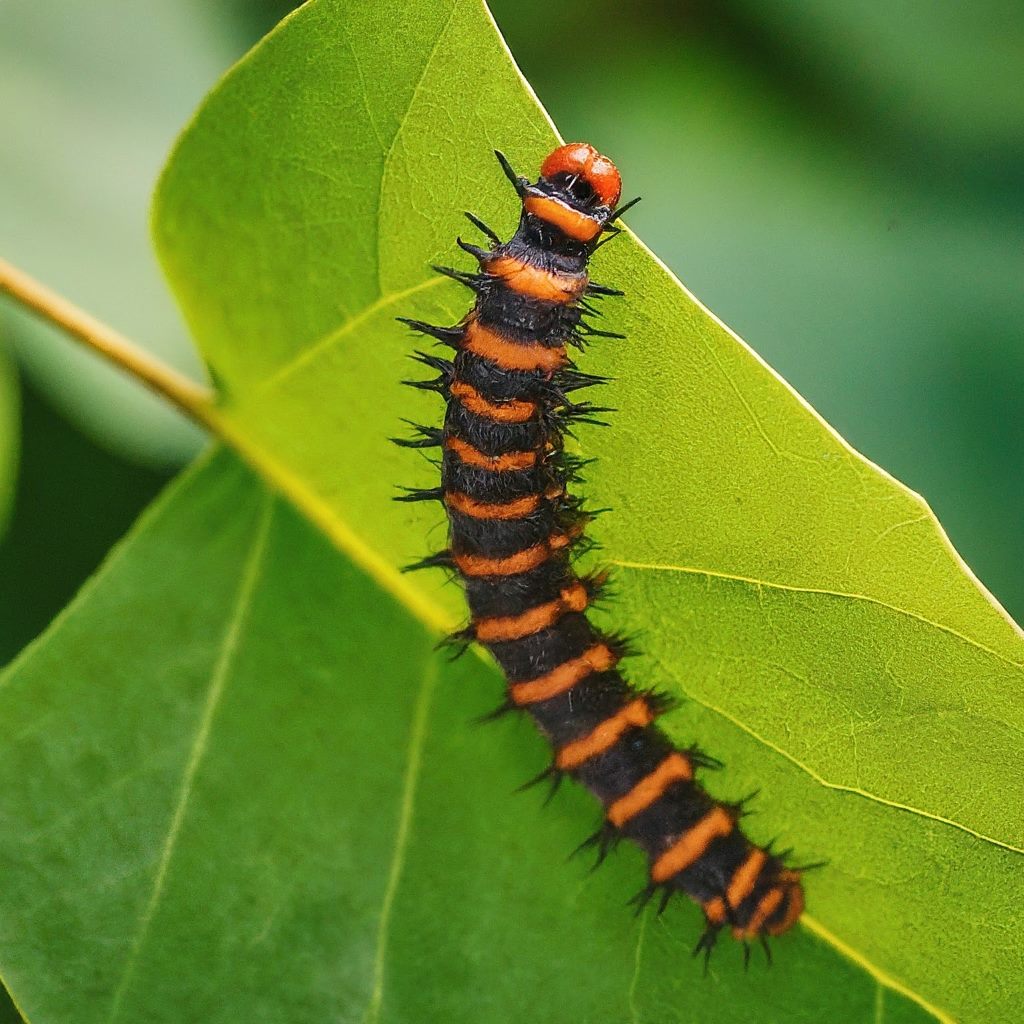
Tulip-tree Beauty Caterpillar
Scientific Name: Epimecis hortaria
Habitat: Tulip-tree Beauty Caterpillars inhabit deciduous forests, woodlands, and suburban areas across North America, where their host plants are commonly found.
Description: These caterpillars have a green body with white, yellow, and black markings along their bodies. They have a cylindrical shape and move with a looping or crawling motion.
Diet: Tulip-tree Beauty Caterpillars feed on the leaves of tulip poplar trees (Liriodendron tulipifera), consuming the foliage as they grow.
Host Plants: Tulip poplar trees (Liriodendron tulipifera) serve as the primary host plants for the Tulip-tree Beauty Caterpillar, providing ample food sources throughout their development.

Two-tailed Swallowtail Caterpillar
Scientific Name: Papilio multicaudata
Habitat: Two-tailed Swallowtail Caterpillars inhabit a variety of habitats, including forests, woodlands, and suburban areas, where their host plants grow abundantly.
Description: These caterpillars have a green body with two distinct tails on their rear end. They have a cylindrical shape and move with a looping or crawling motion.
Diet: Two-tailed Swallowtail Caterpillars feed on the leaves of various trees, including citrus trees (Citrus spp.), consuming the foliage as they grow.
Host Plants: Various trees, including citrus trees, serve as host plants for the Two-tailed Swallowtail Caterpillar, providing ample food sources throughout their development.
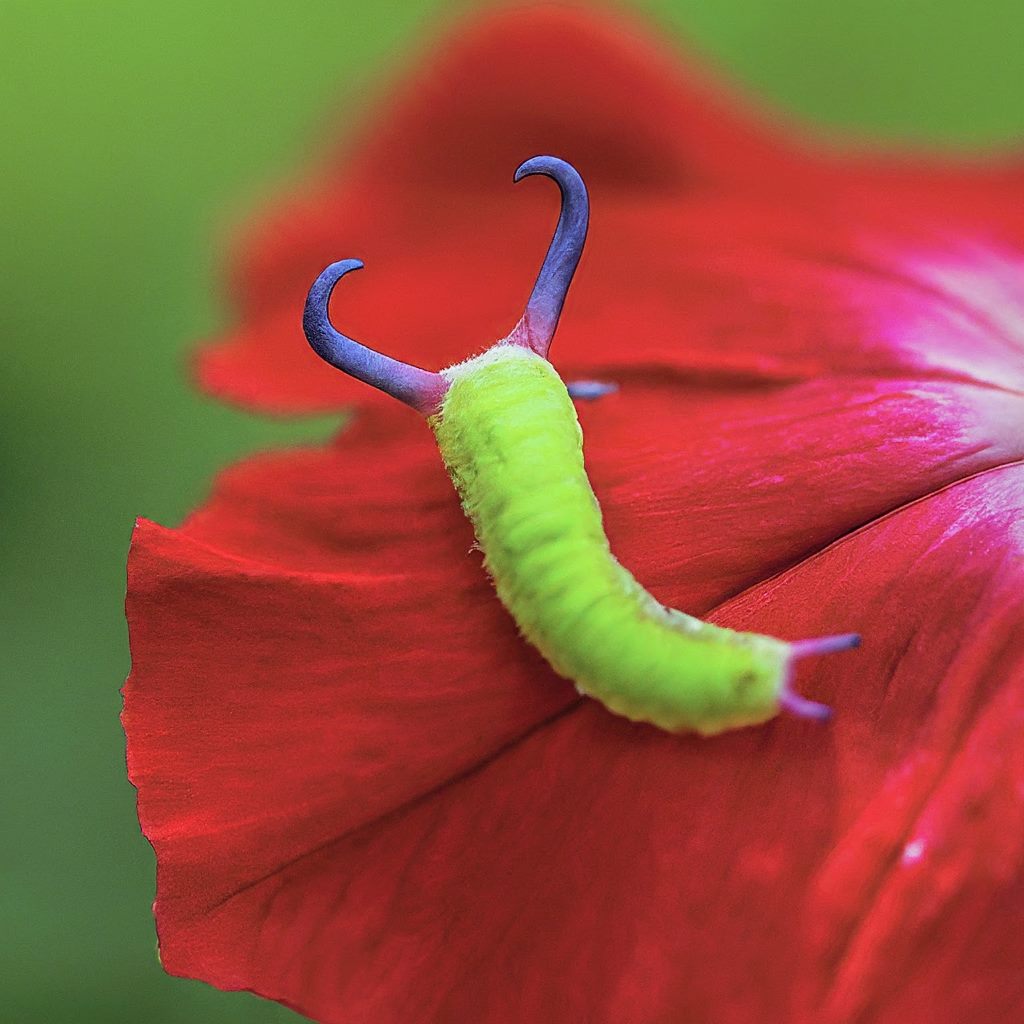
Unicorn Moth Caterpillar
Scientific Name: Schizura unicornis
Habitat: Unicorn Moth Caterpillars inhabit deciduous forests, woodlands, and suburban areas across North America, where their host plants are commonly found.
Description: These caterpillars have a green body with a single “horn” on their back, resembling the mythical creature after which they are named. They have a cylindrical shape and move with a looping or crawling motion.
Diet: Unicorn Moth Caterpillars feed on the leaves of various trees, including oaks (Quercus spp.) and cherries (Prunus spp.), consuming the foliage as they grow.
Host Plants: Various trees, including oaks and cherries, serve as host plants for the Unicorn Moth Caterpillar, providing ample food sources throughout their development.
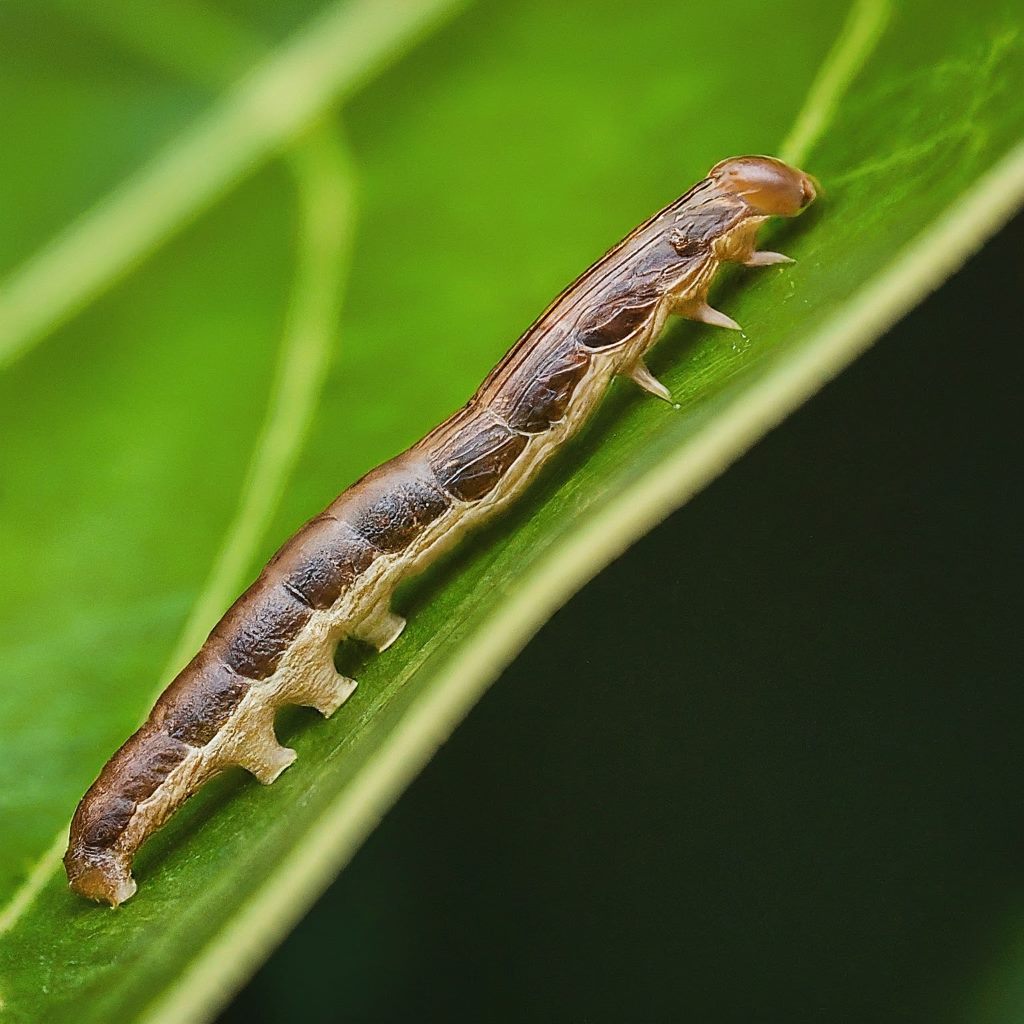
Variegated Cutworm
Scientific Name: Peridroma saucia
Habitat: Variegated Cutworms inhabit a variety of habitats, including grasslands, meadows, and agricultural areas, where their host plants are commonly found.
Description: These caterpillars exhibit variable colors and patterns, ranging from brown to gray with darker markings and spots. They have a cylindrical shape and move with a looping or crawling motion.
Diet: Variegated Cutworms are generalist feeders, consuming the foliage, stems, and roots of various crops and plants, including corn, beans, and lettuce.
Host Plants: Various crops and plants serve as host plants for the Variegated Cutworm, posing a threat to agricultural productivity and crop yields.
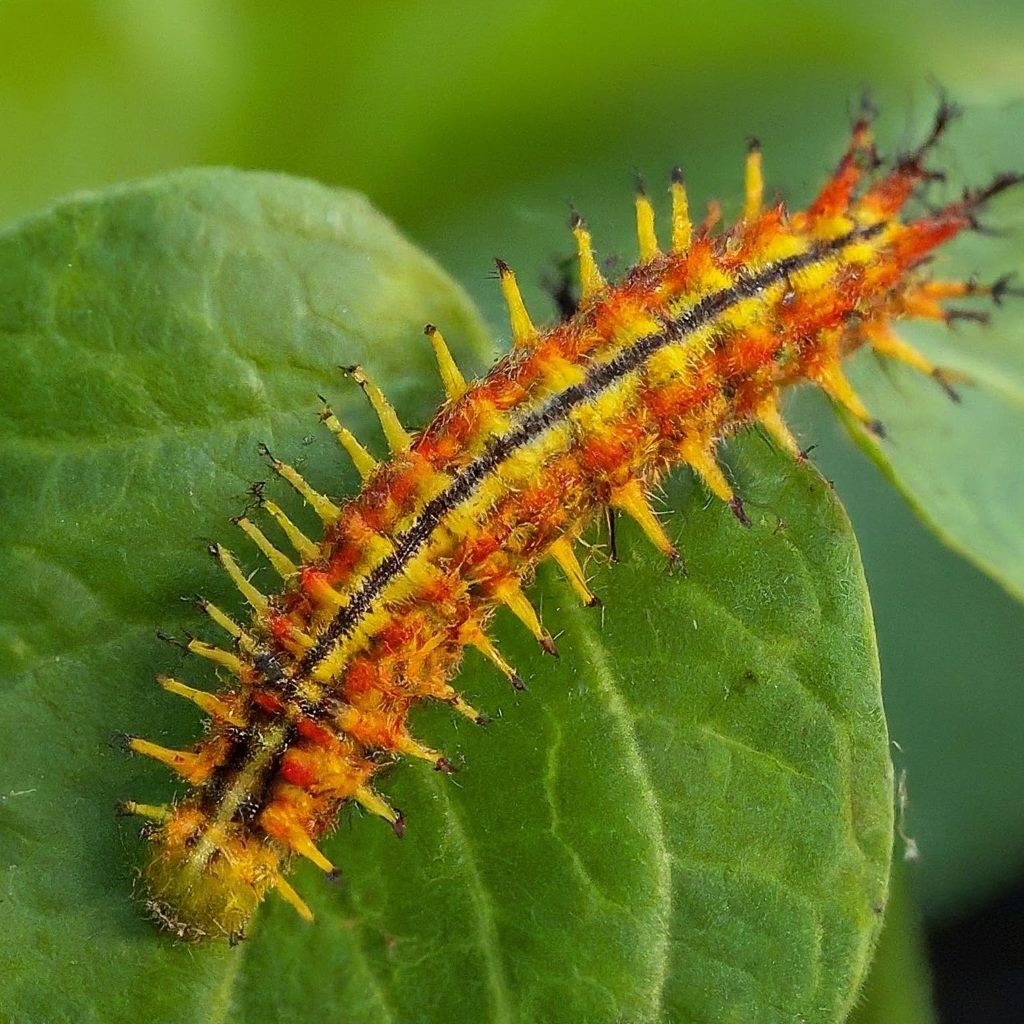
Variegated Fritillary Caterpillar
Scientific Name: Euptoieta claudia
Habitat: Variegated Fritillary Caterpillars inhabit a variety of habitats, including grasslands, meadows, and woodland edges, where their host plants grow abundantly.
Description: These caterpillars have a black body with orange bands and spines along their bodies. They have a cylindrical shape and move with a looping or crawling motion.
Diet: Variegated Fritillary Caterpillars feed on the leaves of various violets (Viola spp.) and passionflowers (Passiflora spp.), consuming the foliage as they grow.
Host Plants: Various violets and passionflowers serve as host plants for the Variegated Fritillary Caterpillar, providing ample food sources throughout their development.
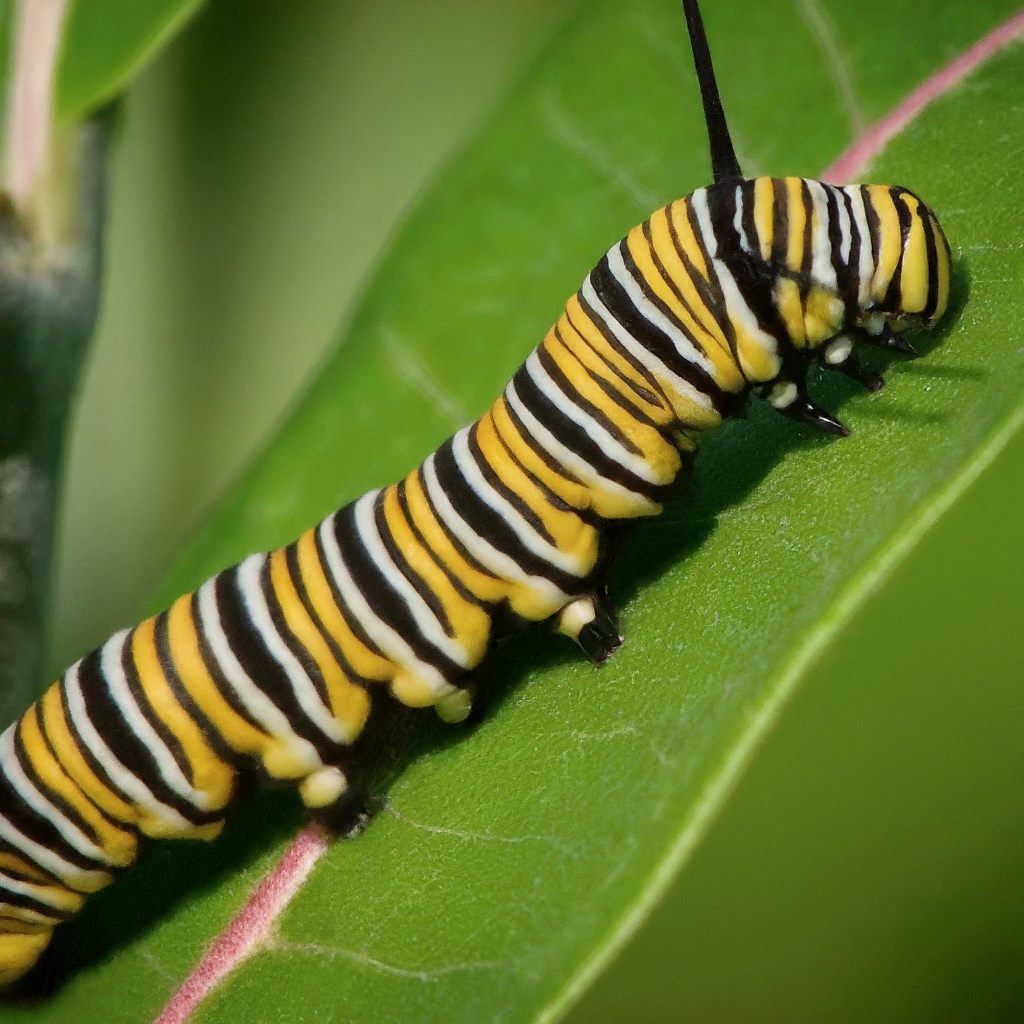
Viceroy Caterpillar
Scientific Name: Limenitis archippus
Habitat: Viceroy Caterpillars inhabit a variety of habitats, including forests, woodlands, and suburban areas, where their host plants grow abundantly.
Description: These caterpillars have a black body with spines and white markings along their bodies. They have a cylindrical shape and move with a looping or crawling motion.
Diet: Viceroy Caterpillars feed on the leaves of various trees, including willow (Salix spp.), poplar (Populus spp.), and other members of the Salicaceae family.
Host Plants: Willow, poplar, and other trees serve as host plants for the Viceroy Caterpillar, providing ample food sources throughout their development.
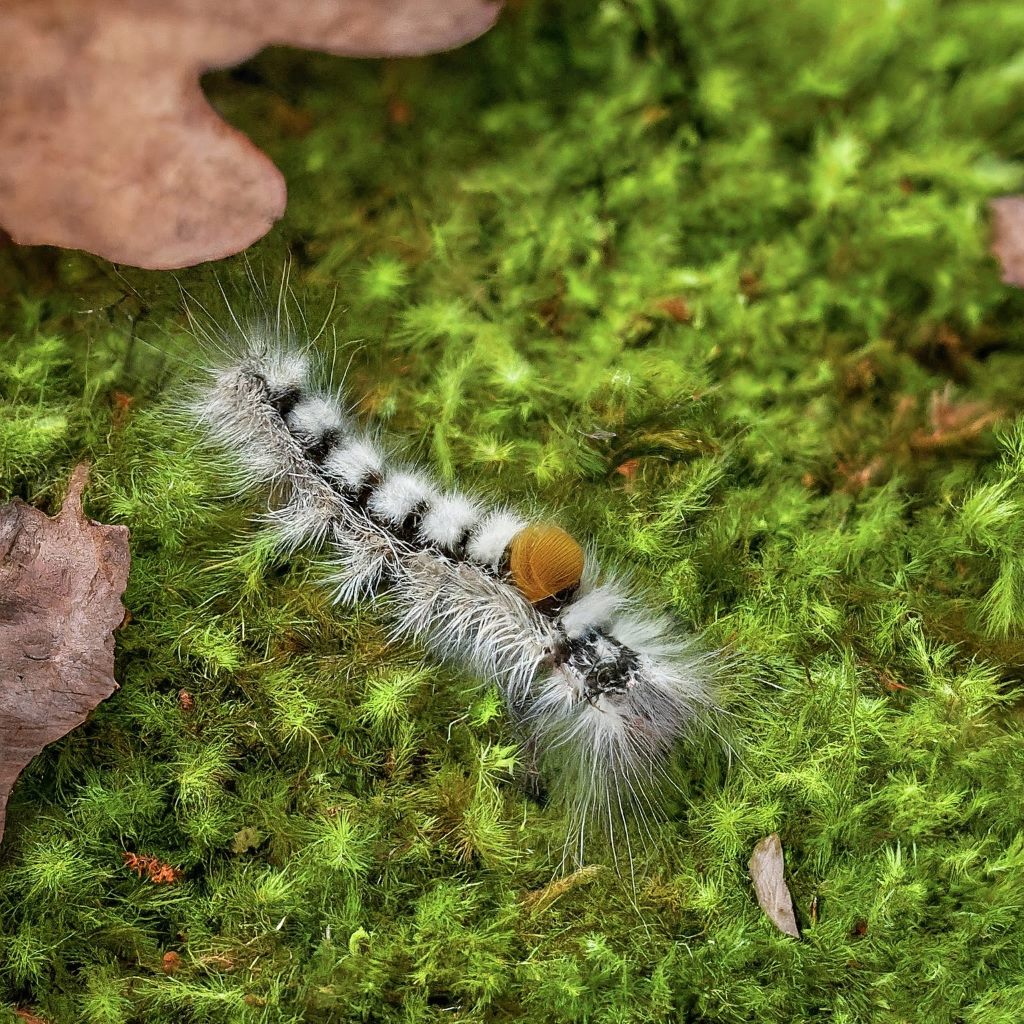
Wedgling Moth Caterpillar
Scientific Name: Eutrapela clemataria
Habitat: Wedgling Moth Caterpillars inhabit deciduous forests, woodlands, and suburban areas across North America, where their host plants are commonly found.
Description: These caterpillars have a green body with wedge-shaped markings along their bodies. They have a cylindrical shape and move with a looping or crawling motion.
Diet: Wedgling Moth Caterpillars feed on the leaves of various trees, including oaks (Quercus spp.), consuming the foliage as they grow.
Host Plants: Various trees, including oaks, serve as host plants for the Wedgling Moth Caterpillar, providing ample food sources throughout their development.
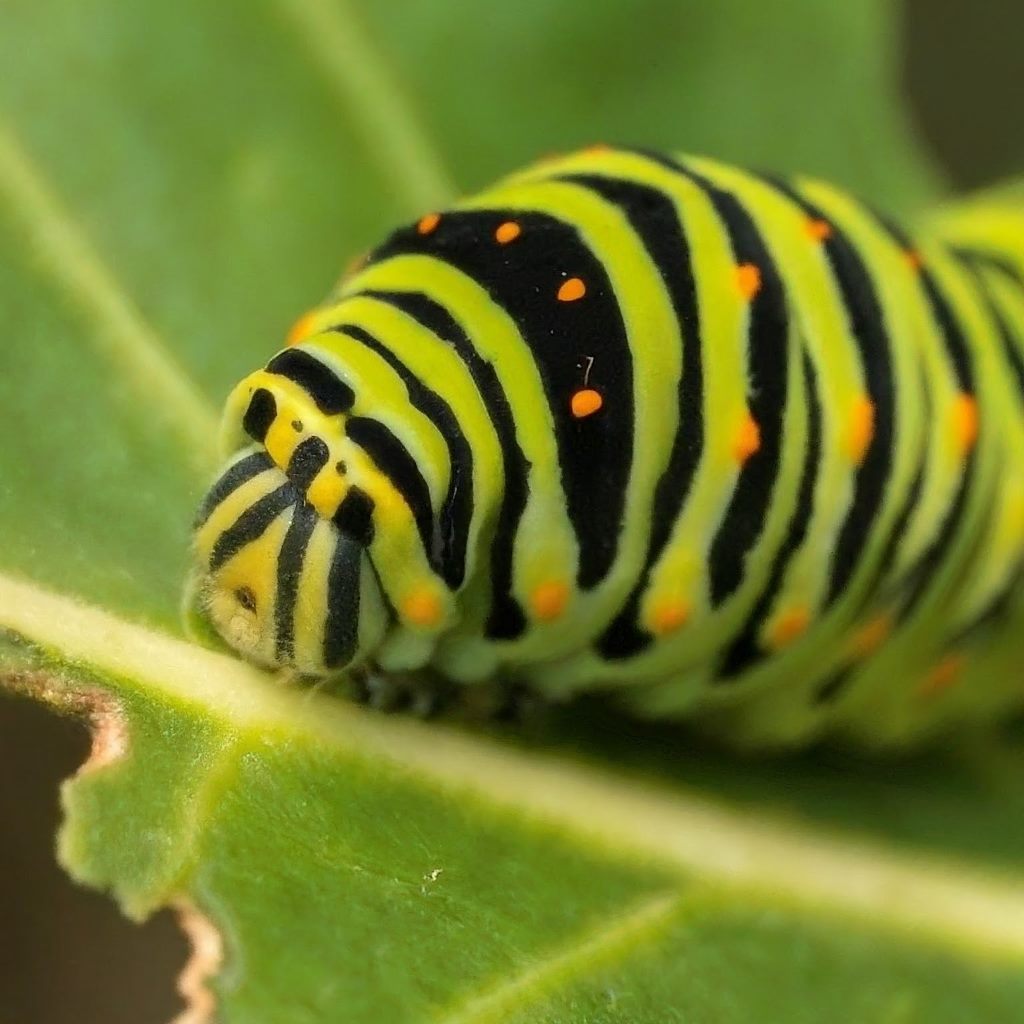
Western Tiger Swallowtail Caterpillar
Scientific Name: Papilio rutulus
Habitat: Western Tiger Swallowtail Caterpillars inhabit deciduous forests, woodlands, and suburban areas across North America, where their host plants are commonly found.
Description: These caterpillars have a green body with black and yellow stripes along their bodies. They have a cylindrical shape and move with a looping or crawling motion.
Diet: Western Tiger Swallowtail Caterpillars feed on the leaves of various trees, including cottonwoods (Populus spp.), consuming the foliage as they grow.
Host Plants: Various trees, including cottonwoods, serve as host plants for the Western Tiger Swallowtail Caterpillar, providing ample food sources throughout their development.
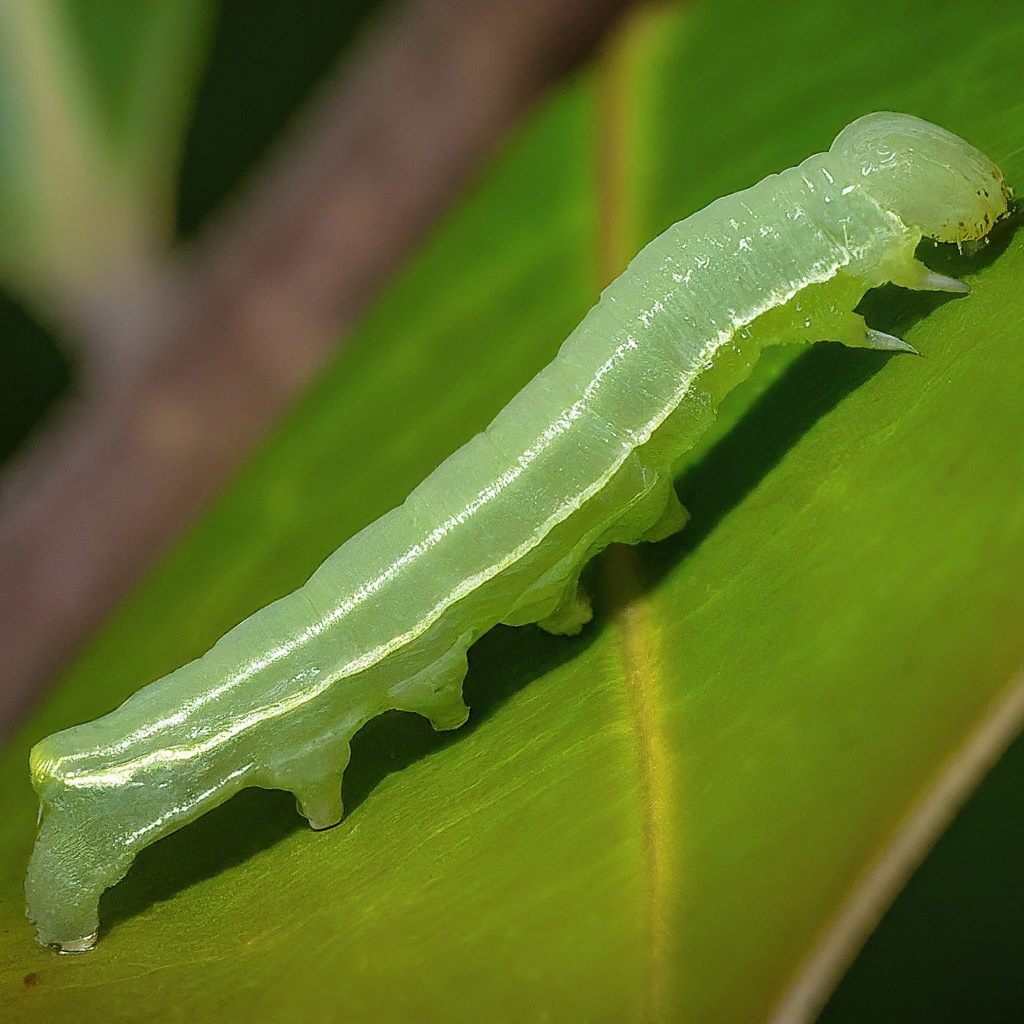
White-speck Moth Caterpillar
Scientific Name: Parcoblatta lata
Habitat: White-speck Moth Caterpillars inhabit a variety of habitats, including forests, woodlands, and suburban areas, where their host plants grow abundantly.
Description: These caterpillars have a white-speckled appearance, providing camouflage among the foliage of various trees and plants. They have a cylindrical shape and move with a looping or crawling motion.
Diet: White-speck Moth Caterpillars feed on the leaves of various trees and plants, consuming the foliage as they grow.
Host Plants: Various trees and plants serve as host plants for the White-speck Moth Caterpillar, providing ample food sources throughout their development.
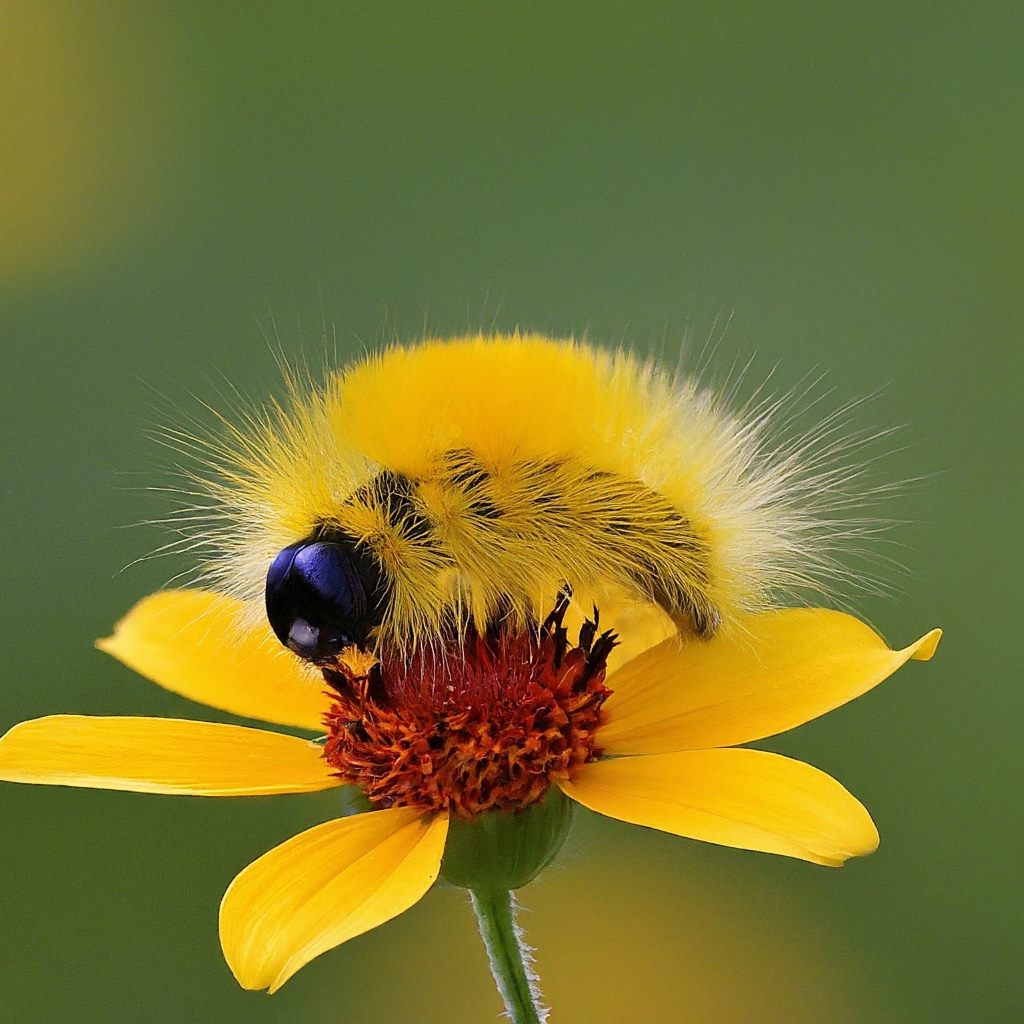
Yellow Woolly Bear Caterpillar
Scientific Name: Spilosoma virginica
Habitat: Yellow Woolly Bear Caterpillars inhabit a variety of habitats, including grasslands, meadows, and woodland edges, where their host plants grow abundantly.
Description: These caterpillars have a yellow body covered in white and black bristles. They have a cylindrical shape and move with a looping or crawling motion.
Diet: Yellow Woolly Bear Caterpillars feed on the leaves of various plants, including clover (Trifolium spp.) and grasses, consuming the foliage as they grow.
Host Plants: Various plants, including clover and grasses, serve as host plants for the Yellow Woolly Bear Caterpillar, providing ample food sources throughout their development.
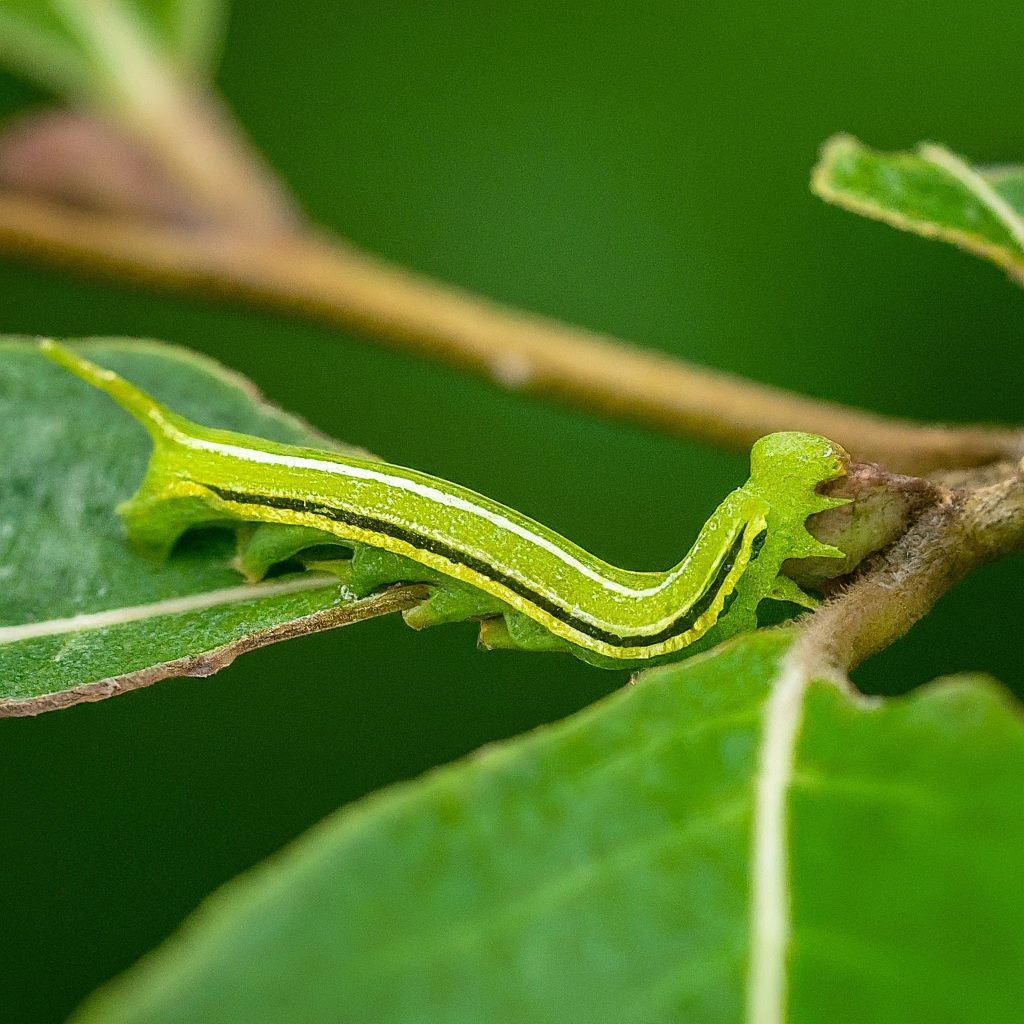
Yellow-Striped Armyworm Caterpillar
Scientific Name: Spodoptera ornithogalli
Habitat: Yellow-Striped Armyworm Caterpillars inhabit a variety of habitats, including grasslands, meadows, and agricultural areas, where their host plants grow abundantly.
Description: These caterpillars have a green body with distinctive yellow stripes along their bodies. They have a cylindrical shape and move with a looping or crawling motion.
Diet: Yellow-Striped Armyworm Caterpillars are voracious feeders, consuming the foliage, stems, and ears of various crops and plants, including corn, cotton, and alfalfa.
Host Plants: Various crops and plants serve as host plants for the Yellow-Striped Armyworm Caterpillar, posing a threat to agricultural productivity and crop yields.
Conclusion:
Brown caterpillars encompass a diverse range of species, each with unique characteristics that contribute to their survival and adaptation strategies. From their coloration and patterns to their behaviors and habitats, these caterpillars showcase the wonders of nature’s design. Understanding the various types of brown caterpillars enriches our appreciation of the intricate ecosystems they inhabit and the crucial role they play in the natural world.

94% of pet owners say their animal pal makes them smile more than once a day. In 2007, I realized that I was made for saving Animals. My father is a Vet, and I think every pet deserves one. I started this blog, “InPetCare”, in 2019 with my father to enlighten a wider audience.
